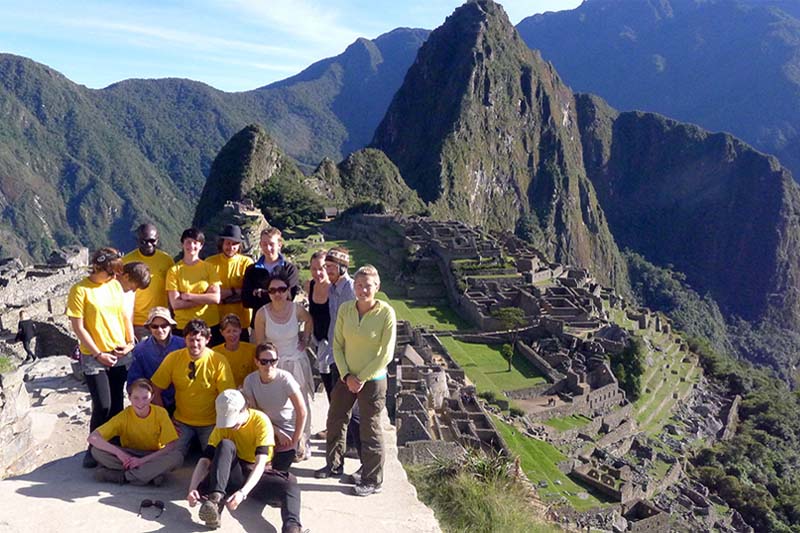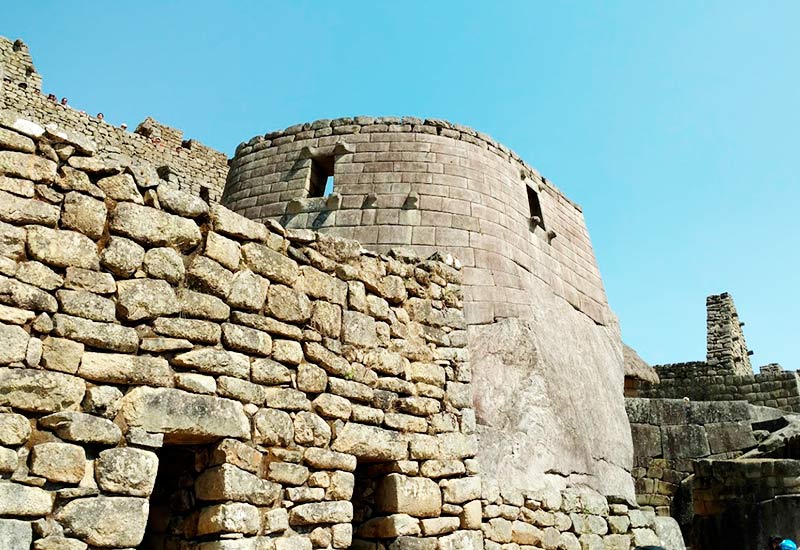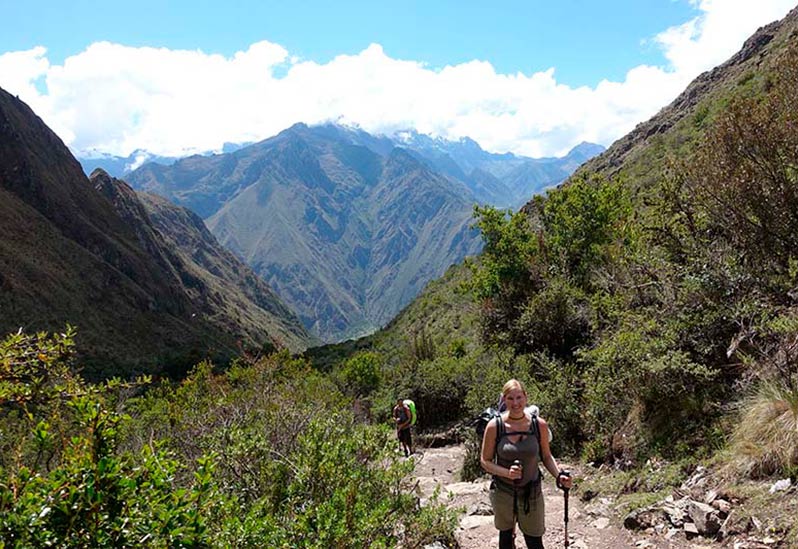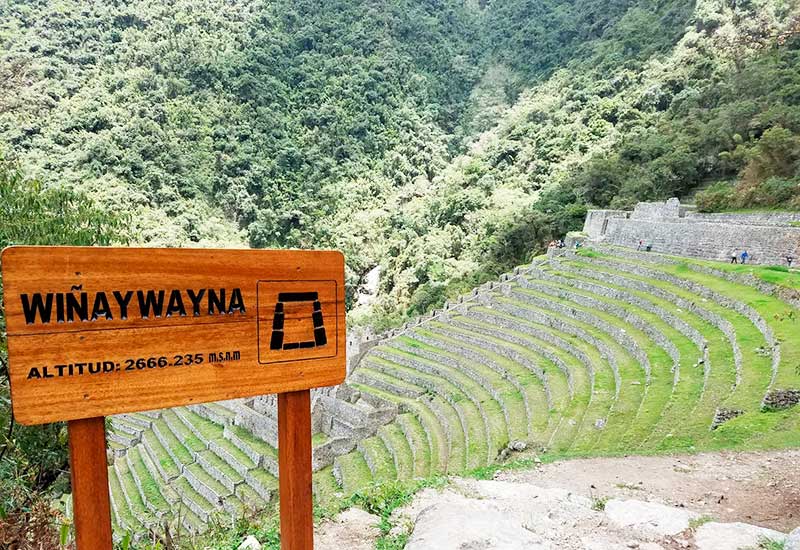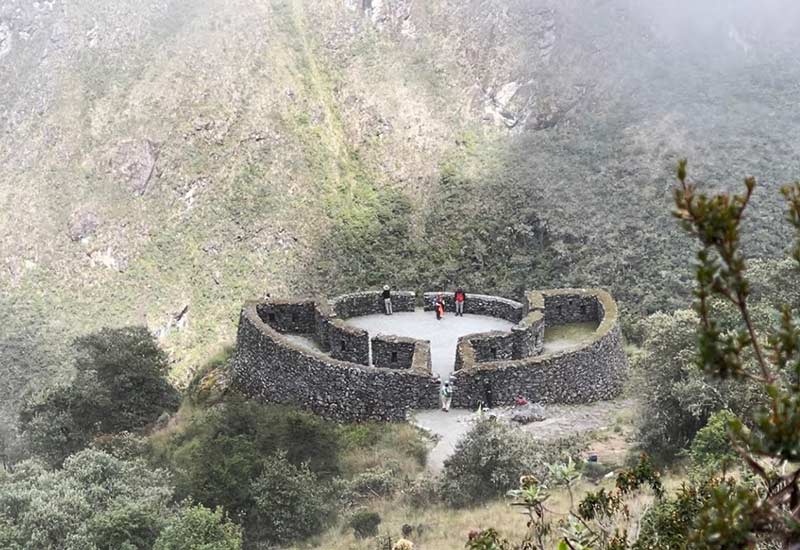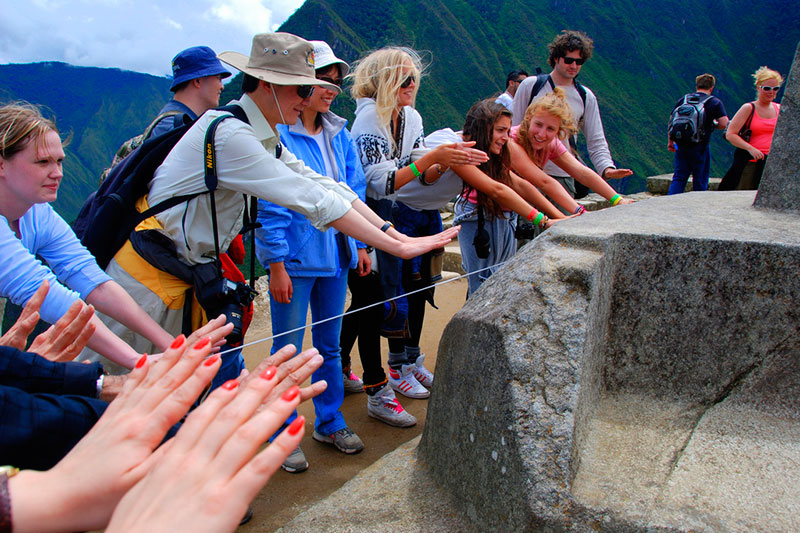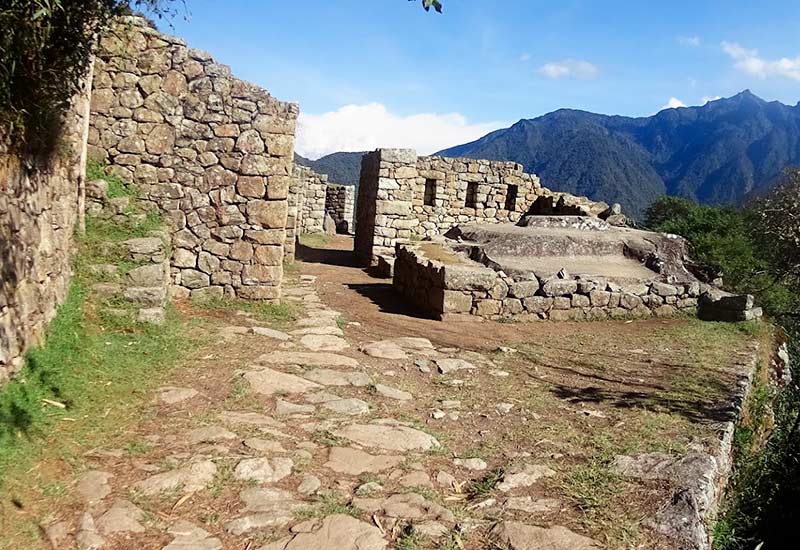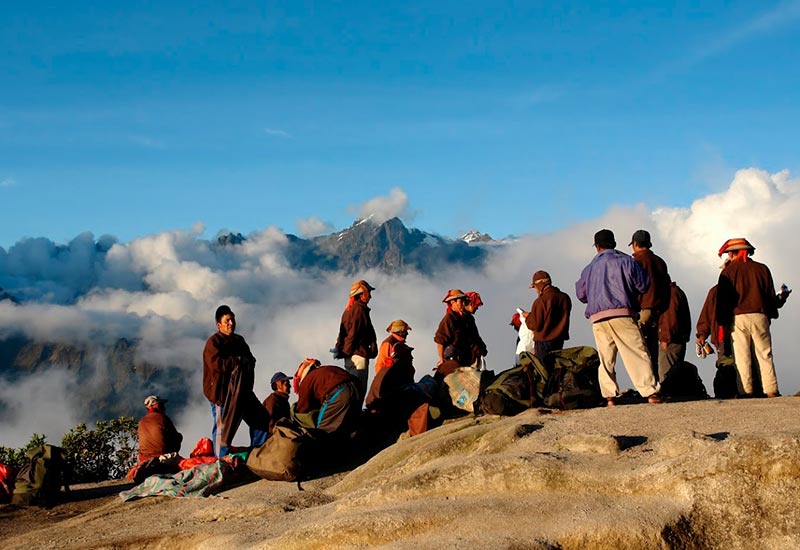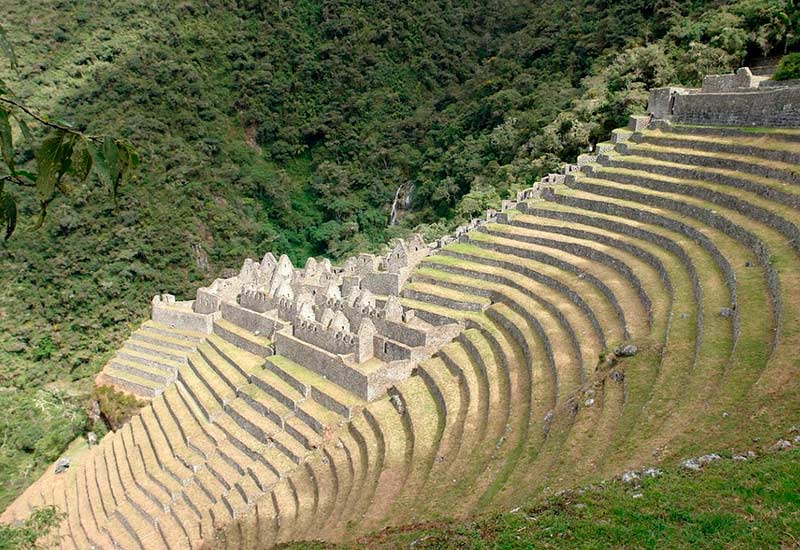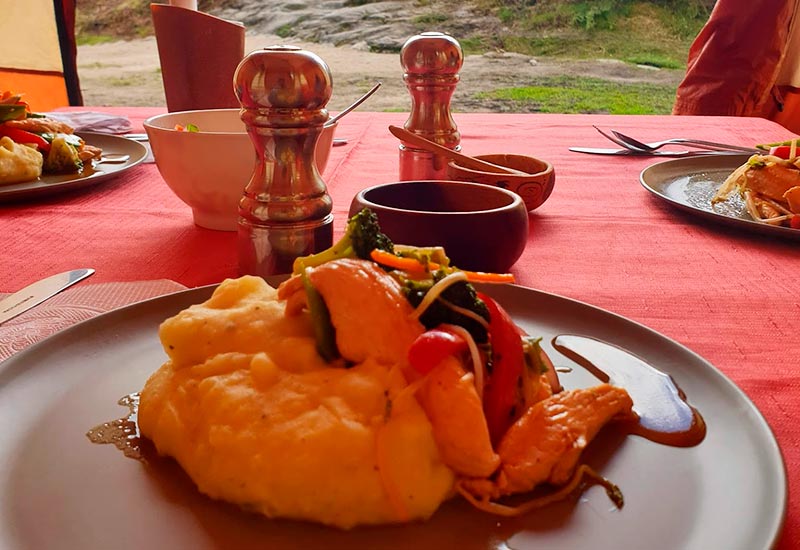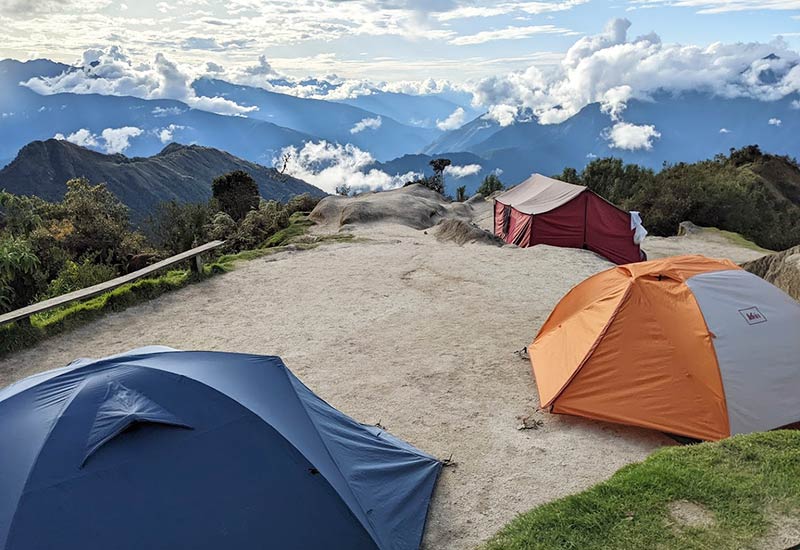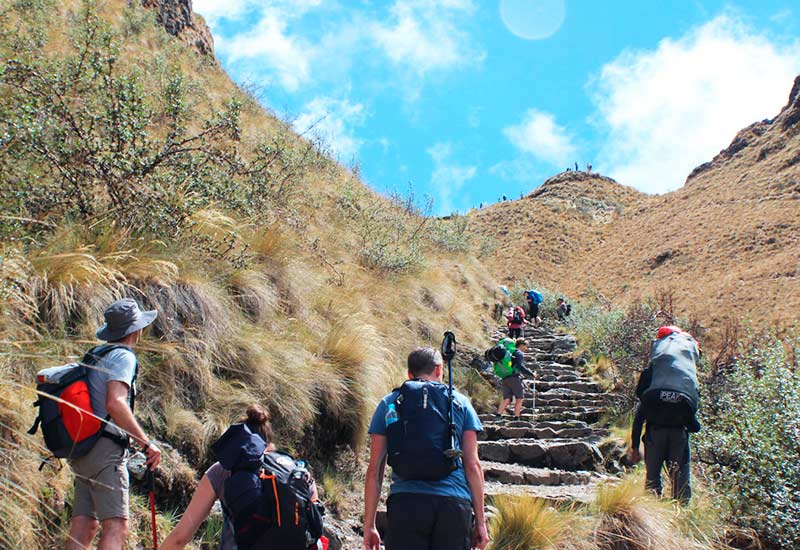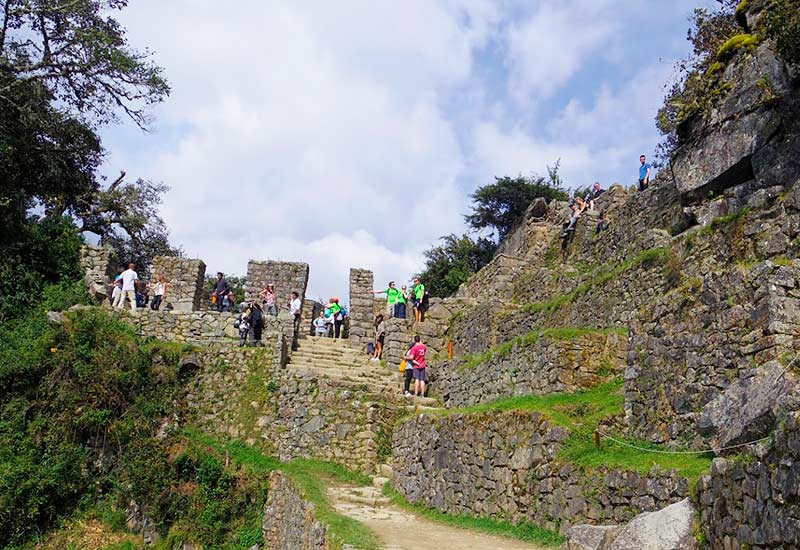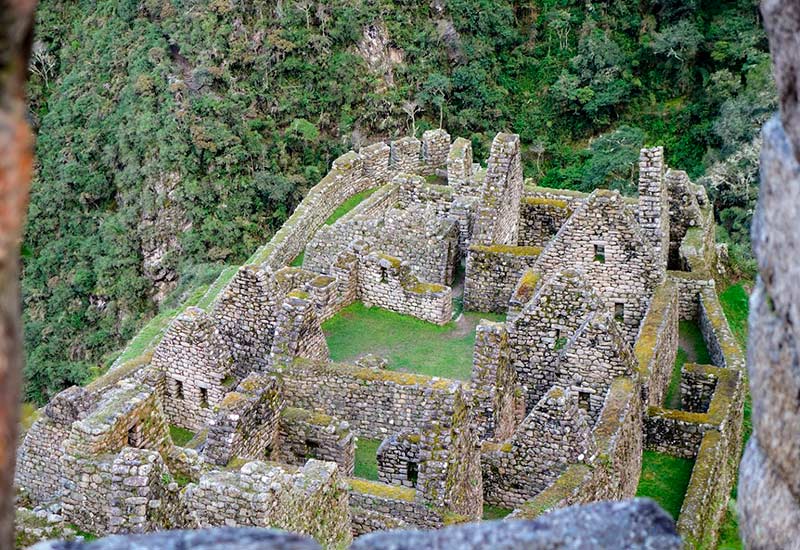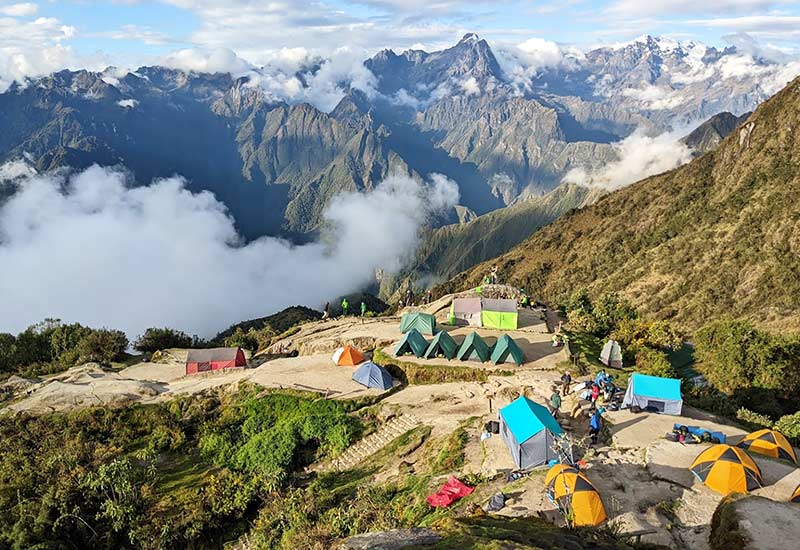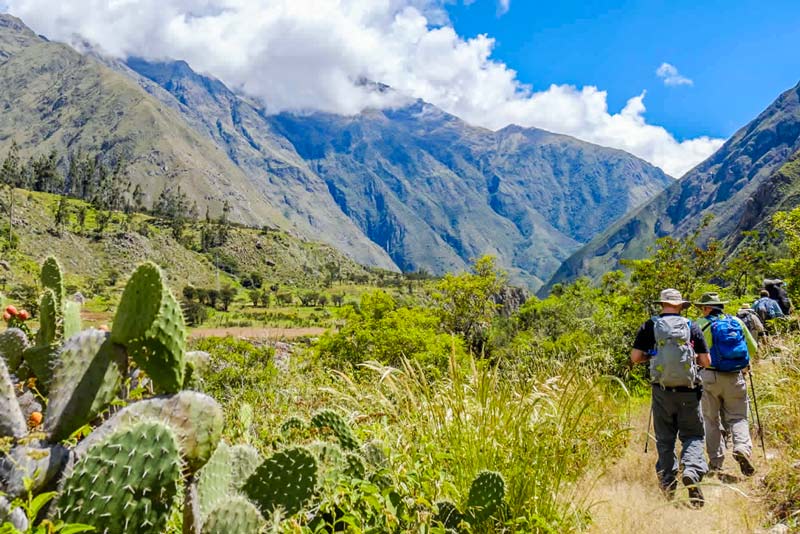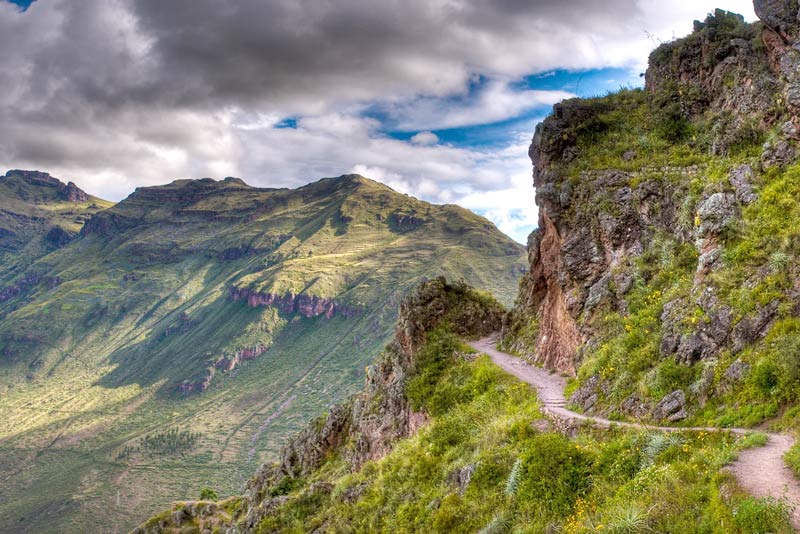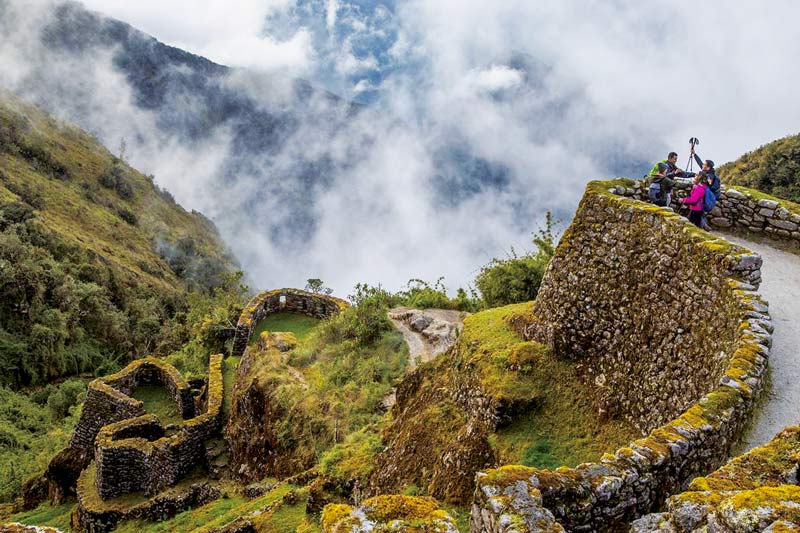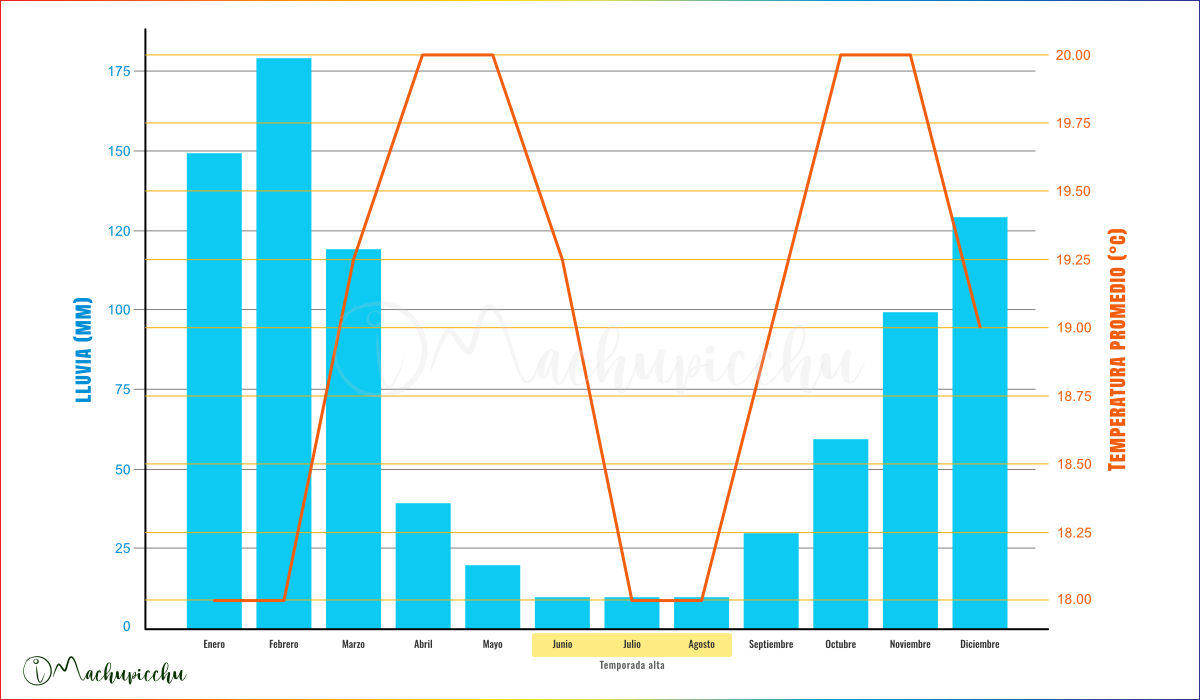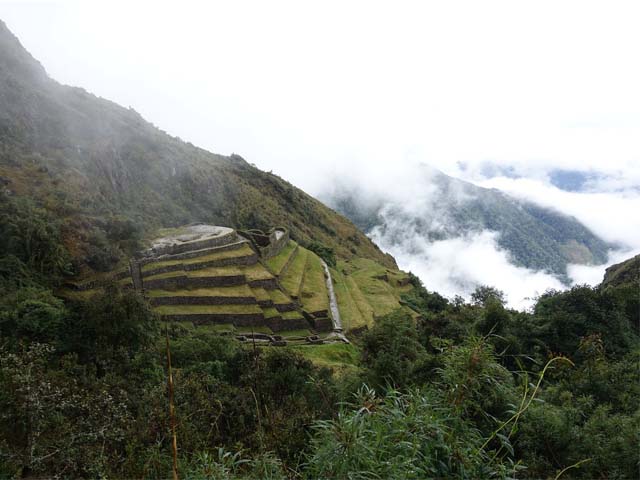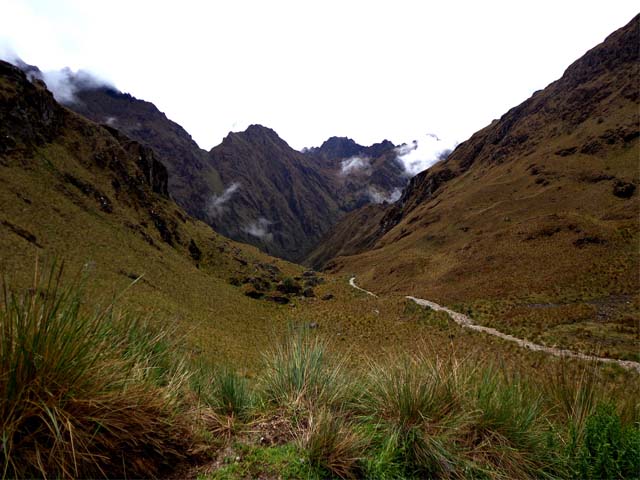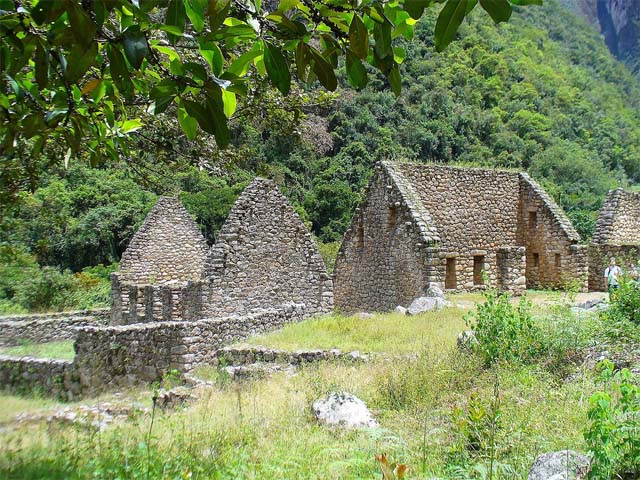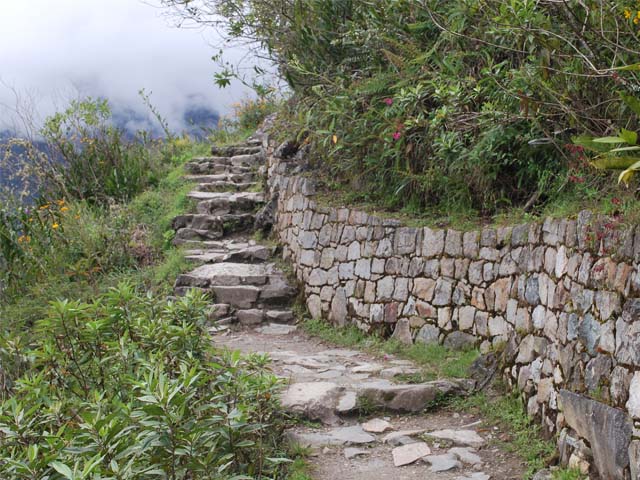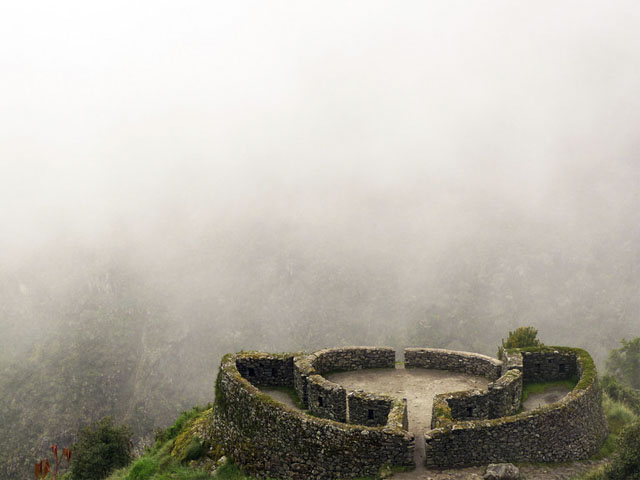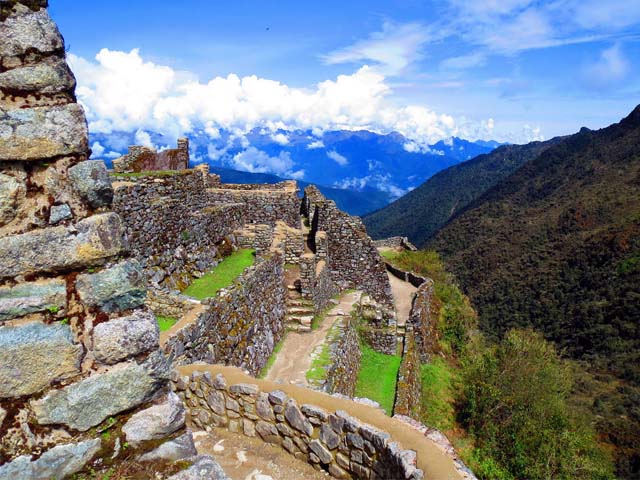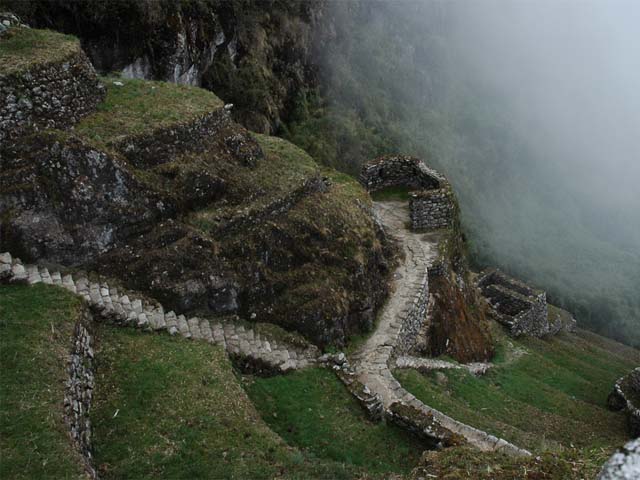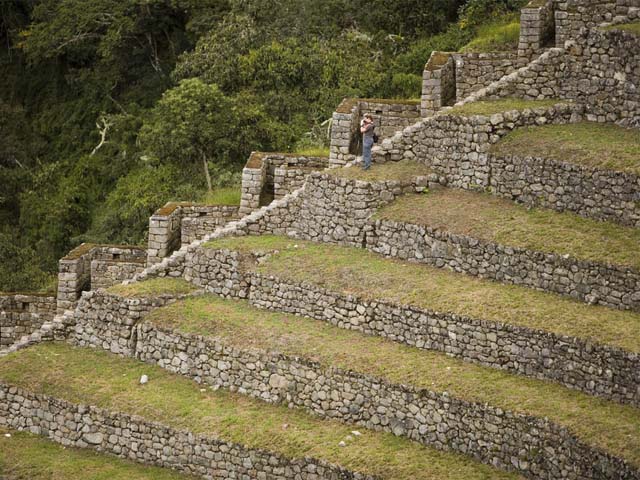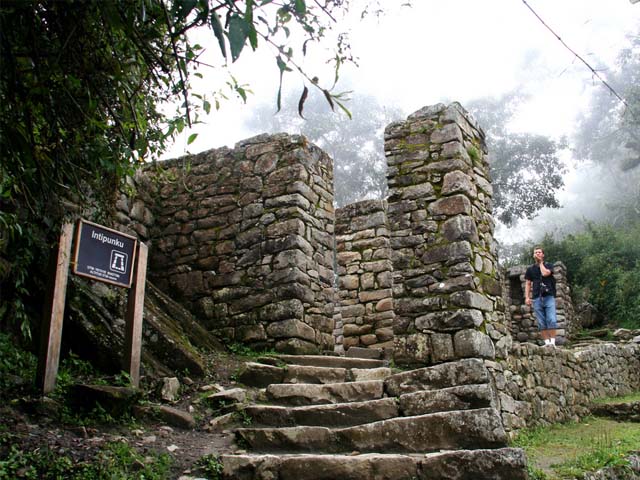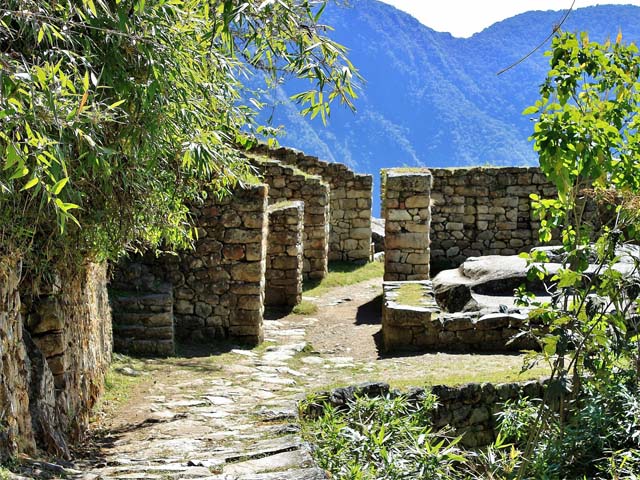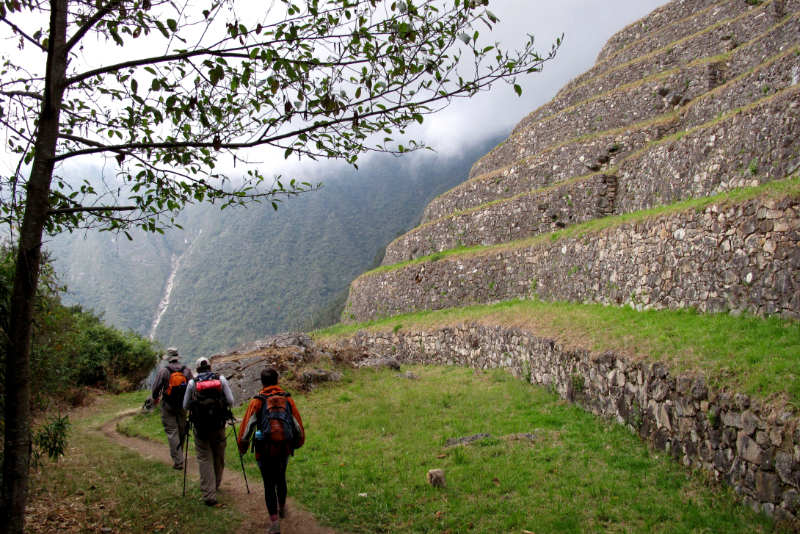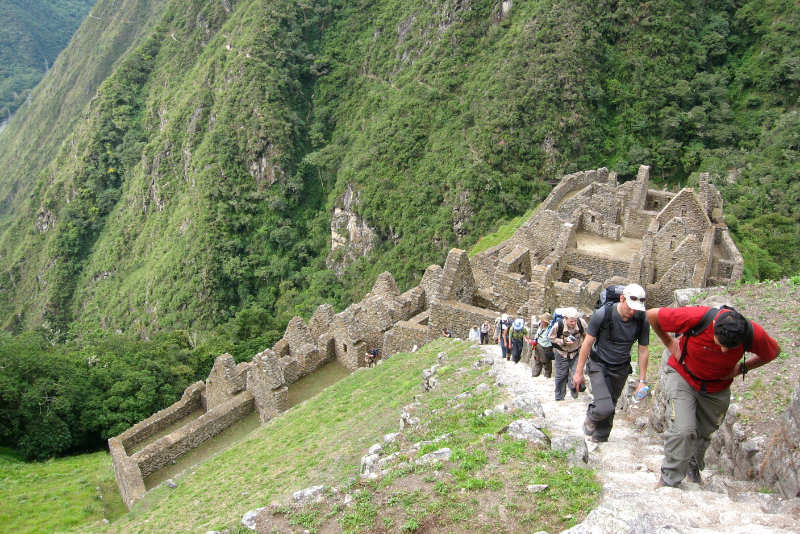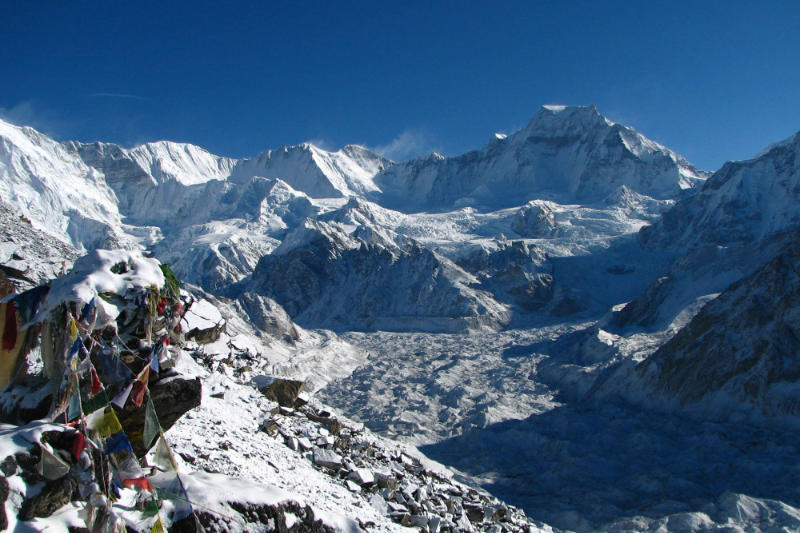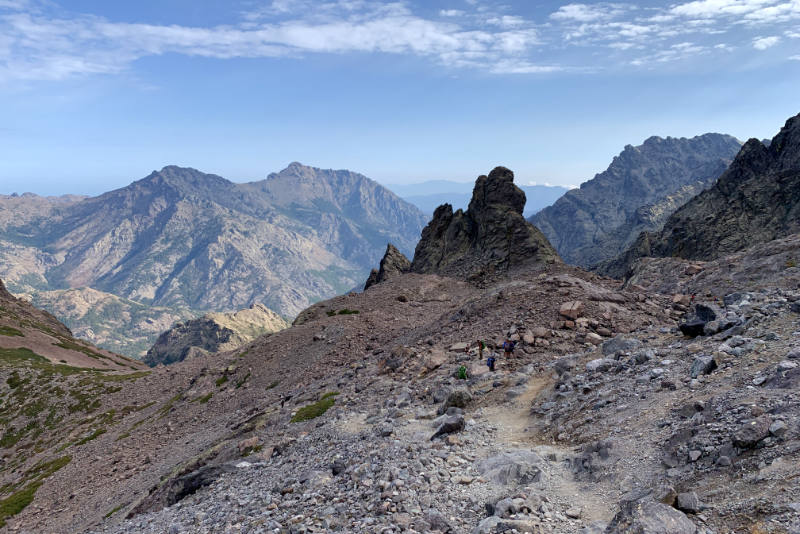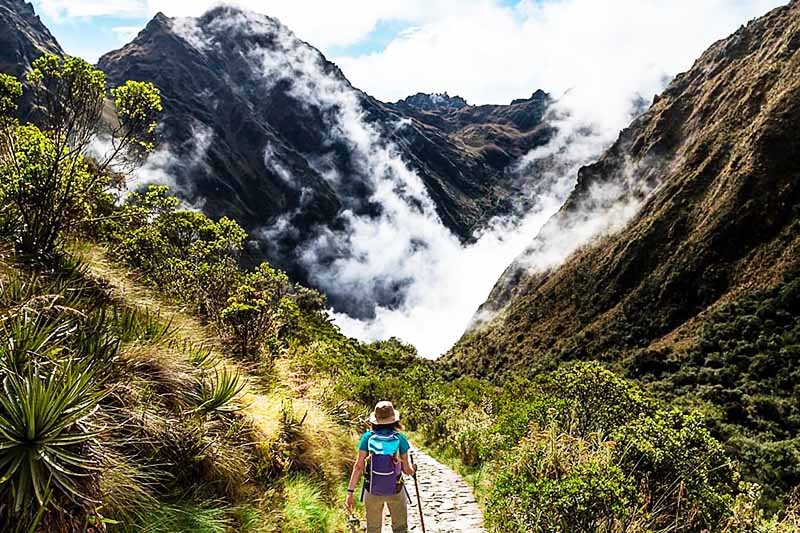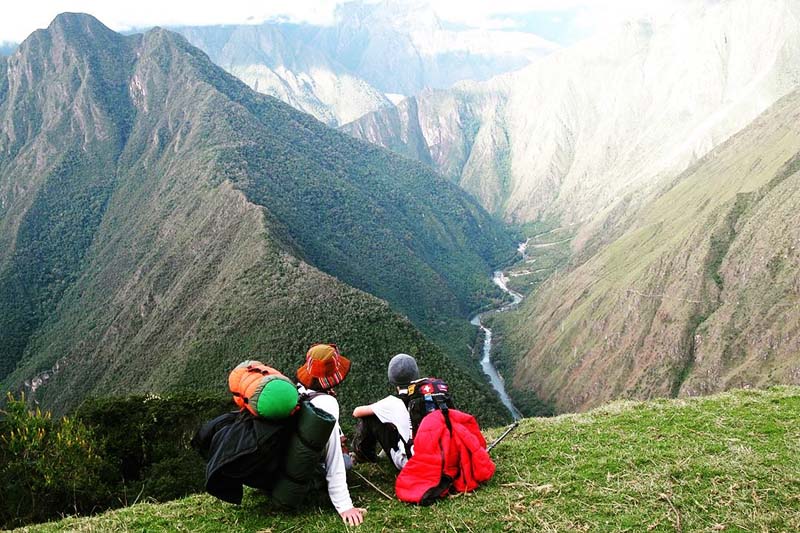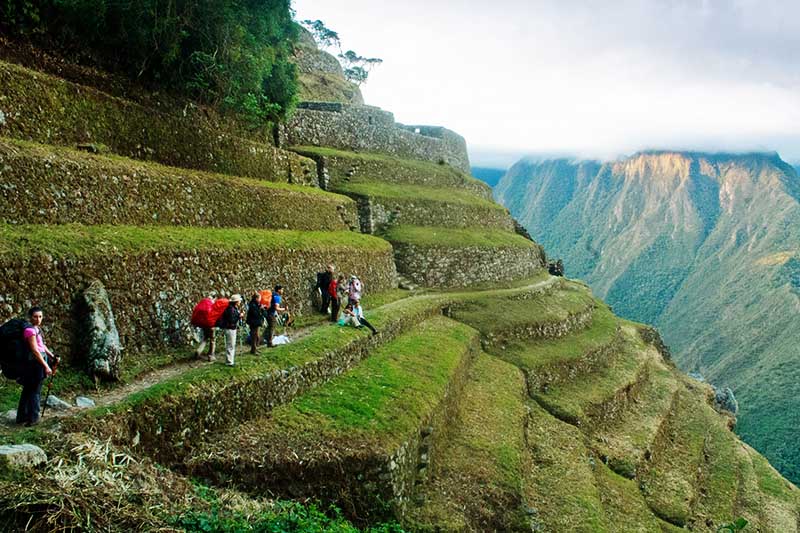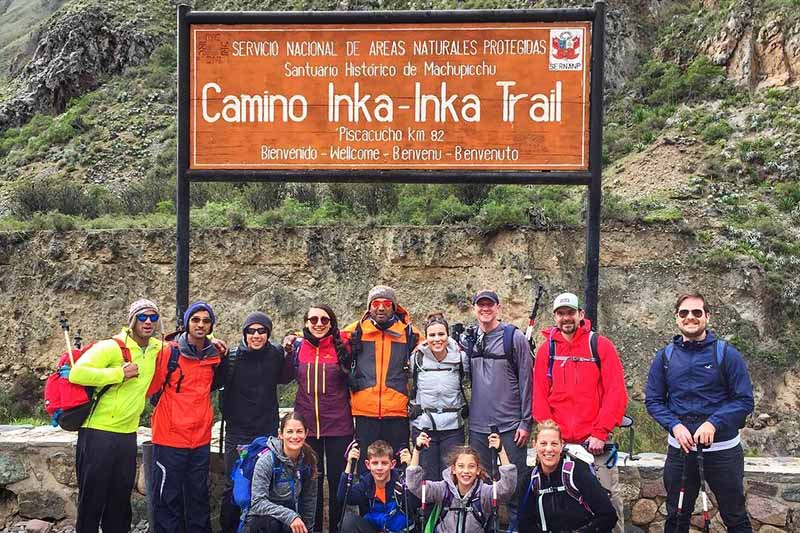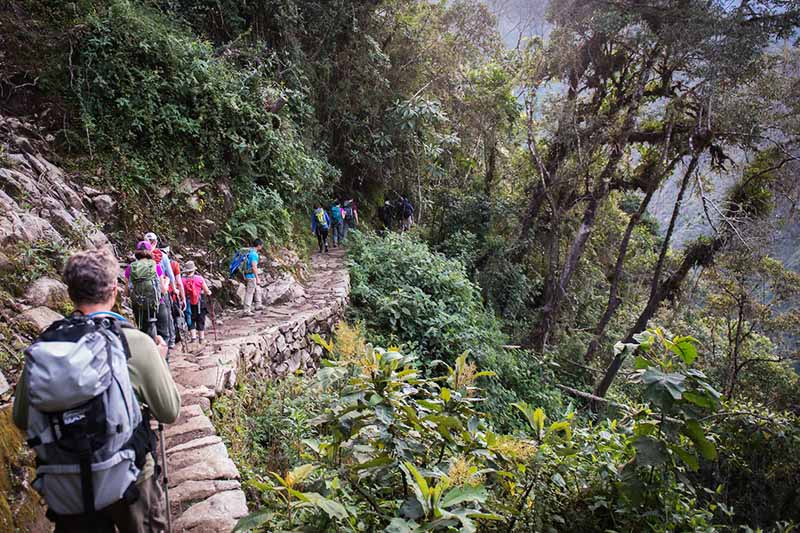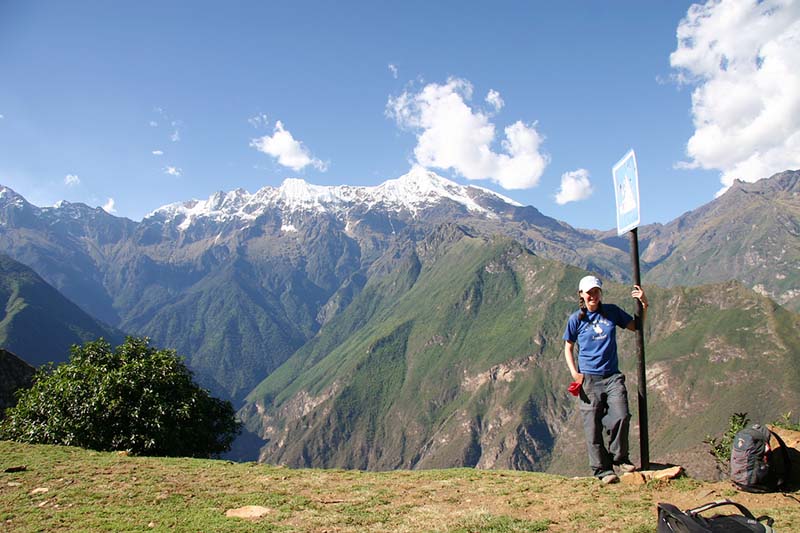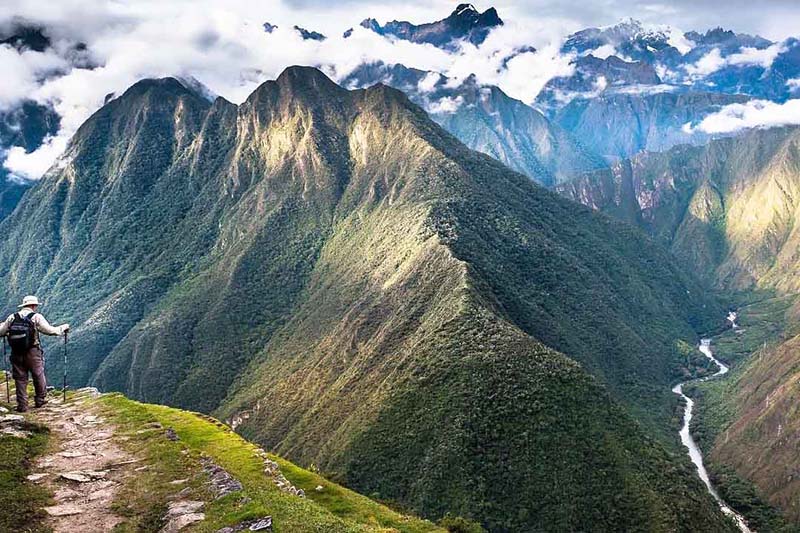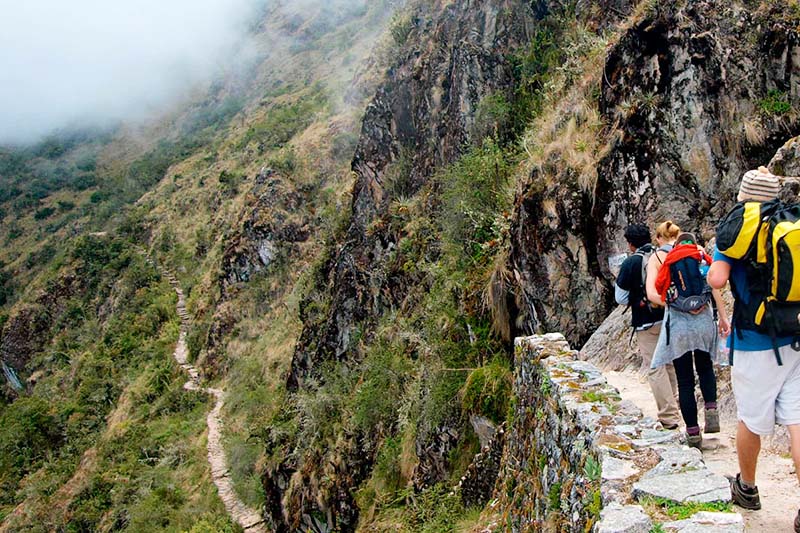The post Book a place for the Inca Trail to Machu Picchu first appeared on Ticket Machu Picchu.
]]>- What is the famous Inca Trail to Machu Picchu?
- How to book the Inca Trail 2025?
- Why book the Inca Trail to Machu Picchu from now on?
- Where to book the Inca Trail to Machu Picchu?
- Other alternatives to the Inca Trail to Machu Picchu
- Questions and answers about the Inca Trail reservation
There are 2 versions of the Inca Trail to Machu Picchu. a) the Classic Inca Trail (4 days) and the Short Inca Trail (2 days). In both cases you must buy the spaces online. The Classic Inca Trail is reserved 5 or 6 months before. The Short Inca Trail, only weeks in advance.
What is the famous Inca Trail to Machu Picchu?
- The Inca Trail is the famous 4-day hiking route until arriving at Machu Picchu through the Puerta del Sol (Intipunku), just as the Incas did hundreds of years ago.
- This ancient Inca route was cut to 39.6 kilometers for the passage of tourists. It reaches its highest point in the ‘Pass of the Dead Woman’, at 4,125 meters from the sea (13,533 ft). Then descend through mountainous jungle landscapes until arriving at Machu Picchu, 2,430 meters from the sea (7,972 ft).
- The Inca Trail is considered one of the best walks in the world. As you descend from the Andes to the eyebrow of the Amazon jungle you will see amazing Inca and pre-Inca constructions, such as: Runkurakay, Sayacmarca, Phuyupatamarca and Wiñaywayna.
How to book the Inca Trail 2025?
To make the Inca Trail yes or yes you must reserve your space through a tourism agency. Follow these steps to secure your place on the Inca Trail 2025:
- Enter the website of an authorized tourism agency to offer income to the Inca Trail.
- Choose the date you want to do the Inca Trail and check if there are still spaces available for the Inca Trail 4 days. (The 2-day Inca Trail can be purchased only weeks in advance).
- If there is still availability, take advantage of making your reservation. Just click on ‘Book’ and complete the personal information of you and your companions.
- Make the payment of the tour (includes the entrance to the Inca Trail) by credit or debit card. It is usually done with Visa, MasterCard, American Express, etc.
- Check your email with the payment receipt made.
- One night before the start of the Inca Trail, you will meet your tour guide and receive an informative talk about the complete itinerary for the next day.
Why book the Inca Trail to Machu Picchu from now on?
- To secure your entry to the Inca Trail 4 days you must reserve your permit 5 or 6 months in advance. Remember that the purchase is made through the website of an authorized tourism agency.
- The start of the sale of the Inca Trail begins in October (for the following year). If you want to make the walk in January, March or April ( in February the Inca Trail remains closed ); The most advisable thing is to make the purchase as soon as the sale of spaces begins.
Where to book the Inca Trail to Machu Picchu?
- The Peruvian government ensures the well-being of each of the passengers, requiring them to be part of an excursion group led by a guide and with the help of support staff. Thus, you will not be able to complete the Inca Trail on your own. You can only do it through an authorized tourism agency.
- There are several tourism agencies that offer tours (including income) to the Classic Inca Trail to Machu Picchu. Each one offers its own prices according to the quality of the service they perform.
- In general, a tour of the Inca Trail includes the following: a) entrance to the Inca Trail, b) official tourist guide, c) entrance to Machu Picchu, d) cooks, e) porters, f) return transport and g) equipment camp.
Disconnect some days of the world on the Inca Trail to Machu Picchu. The adventure awaits you but tickets must be purchased 5 or 6 months in advance. We recommend you reserve a space online right now.
Other alternatives to the Inca Trail to Machu Picchu
In addition to the Inca Trail to Machu Picchu there are other hiking trails where spectacular landscapes and experiences are traveled. All must be done through an authorized tourism agency.
- Salkantay – The Salkantay Trek is a 5-day, 4-night hiking trail that runs through high mountain landscapes (runs through the ‘Abra del Salkantay snowy’) until arriving at the Inca City of Machu Picchu along the Aguas Calientes route. Tourists travel approximately 74 kilometers.
- Lares Trek – The Lares Trek is a 4-day and 3-night hiking route that runs through Quechua villages with a lot of tradition such as Lares, Wacahuasi, Willoq and more. In total, tourists travel 37 kilometers on foot until arriving at Machu Picchu on the Aguas Calientes route. It is famous for the cultural experience that the tourist lives during the tour.
- Ausangate Trek – The Ausangate Trek is a hiking trail to the slopes of the famous Ausangate snowfall, the highest in Cusco and one of the highest in Peru. It lasts 6 days and 5 nights and also crosses lagoons, valleys as well as the famous Mountain of the 7 Colors. In total, tourists walk 74 kilometers on foot.
Questions and answers about the Inca Trail reservation
-
Is there an income limit for the Inca Trail?
The number of visitors who are allowed to enter the Inca Trail trails each day is limited to 500 people. However, keep in mind that this figure includes the 300 people who are part of the support staff. This means that only 200 tourists end up entering Machu Picchu each day.
-
When is the Inca Trail closed?
The Inca Trail remains closed throughout February due to the maintenance of the Inca route. Then, this hiking trail remains open the rest of the year.
-
Is the Inca Trail dangerous?
No. The Inca Trail to Machu Picchu has security personnel deployed along the way. In addition, the authorities imposed the tour with an organized tour to avoid informality and protect the integrity of tourists.
-
Can I do the Inca Trail on my own?
No. The Inca Trail to Machu Picchu is done yes or yes through an authorized tourism agency. It is not possible to do this hike on your own.
-
Are there an official website for the sale of revenue to the Inca Trail?
No. The only way to buy the income to the Inca Trail is through the websites of an authorized tourism agency.
-
Can I buy my tour to the Inca Trail once in Cusco?
No. The entrance to the Inca Trail must be purchased 5 or 6 months in advance so that once in the city of Cusco no visitor can find availability.
-
How much does the Inca Trail to Machu Picchu cost?
The prices of the Inca Trail tour vary according to the type of service offered by the authorized tourism agency. Prices vary from 400 to 700 US dollars. Most agencies also offer discounts for students and minors.
By Ticket Machu Picchu – Last updated, January 2, 2025
The post Book a place for the Inca Trail to Machu Picchu first appeared on Ticket Machu Picchu.
]]>The post Are there spaces available for the Inca Trail 2025? first appeared on Ticket Machu Picchu.
]]>- Are there spaces available for the Inca Trail?
- How many versions are there of the Inca Trail?
- The 4-day Classic Inca Trail
- The Short Inca Trail of 2 days
- How to obtain the Inca Trail permits?
- And how is the Inca Trail?
- Questions and answers about the availability of the Inca Trail 2025
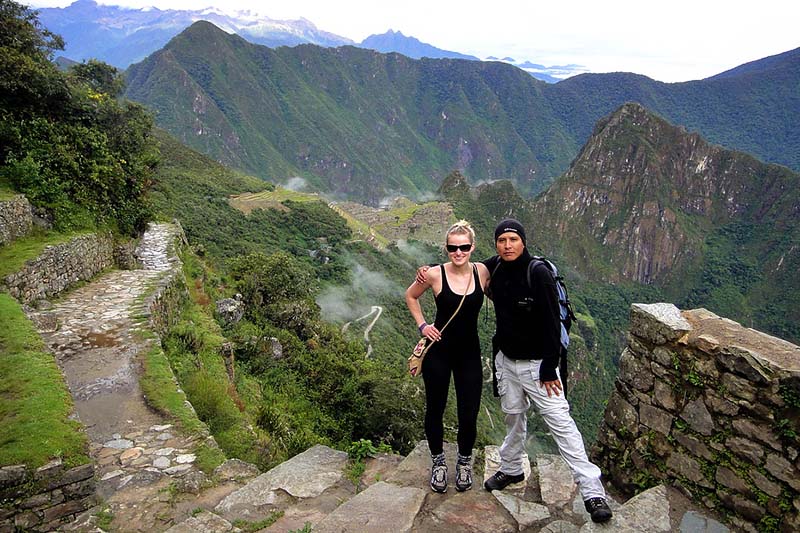
The Inca road to Machu Picchu
Do you want to make the Inca Trail to Machu Picchu? The most important thing is to acquire permission to enter. This is done online (through the website of an authorized agency) and 6 months in advance. Otherwise, you will not find availability.
Are there spaces available for the Inca Trail?
- The Inca Trail offers the daily income of 500 people. Of that number, 300 belong to the trekking support team. Therefore, only 200 tourists will end up entering Machu Picchu on the Inca Trail each day.
- The low number of available spaces makes it necessary to buy the entrance to the Inca Trail in advance. It is recommended to enter the internet and reserve the entrance to the Inca Trail 6 months in advance.
- Visitors who wish to buy their entrance to the Inca Trail for the following year, must make the purchase from October (on that date the sale of income to the Inca Trail begins).
Check the availability calendar to check for free spaces:
- Choose the type of Inca Trail you prefer: the ‘Classic 4 days’ version or the ‘Short 2 days’ version.
- Choose the month and day you want to start the Inca Trail route.
- Check that there is current availability of the Inca Trail on the date you chose.
- If you did not find availability, look for a different date than the chosen one (it is recommended to make the purchase 6 months before).
How many versions are there of the Inca Trail?
- There are 2 versions of the Inca Trail to Machu Picchu: the ‘Classic’ 4-day hike and the ‘Short’ hike of only 2 days. Both travel ancient Inca trails built hundreds of years ago as well as the entrance to the Inca City of Machu Picchu.
- The Inca Trail ‘Classic 4 days’ is preferred by tourists. This is mainly due to the adventure it represents and the landscapes it travels. The ‘Inca Trail of 2 days’, however, is preferred by tourists who do not have much vacation time or who did not get a tour to the ‘Classic Inca Trail’ in time.
The 4-day Classic Inca Trail
The Classic Inca Trail lasts 4 days and 3 nights. It covers approximately 43 kilometers of mountainous geographies and jungles. It crosses Inca archaeological sites such as: Runkuracay, Wiñaywayna, Patallacta and, of course, Machu Picchu. The entrance to the Inca City is through the famous Puerta del Sol (Intipunku) , the original entrance gate in the time of the Incas.
- Type of trip: hiking, camping, adventure, history, culture.
- Total distance: 43 kilometers / 26 miles.
- Recommended: For people who enjoy hiking and have a moderate physical level.
- Difficulty: Challenging
- Considerations: You need to buy income in advance.
The Short Inca Trail of 2 days
The Short Inca Trail lasts only 2 days and 1 night. It travels approximately 10 kilometers. In addition to Machu Picchu includes the visit to the archaeological site of Wiñaywayna. The tour includes 1 hotel night in the town of Aguas Calientes.
- Type of trip: hiking, adventure, history, culture.
- Total distance: 10 kilometers.
- Recommended: For people who are looking for adventure and have a moderate physical state.
- Difficulty: Moderate
- Considerations: Revenue can be purchased days in advance.
How to obtain the Inca Trail permits?
- There is no way to enter the Inca Trail if it is not through an authorized travel agency. The agencies offer admission to the trek as well as: full transport, cooks, porters, camping equipment, tour guide, Machu Picchu entrance and more.
And how is the Inca Trail?
- The tour of the historic Inca Trail is commonly known as one of the best walks the world has to offer. The route does not need previous experience, just a pair of comfortable hiking boots and the desire to reach the goal.
- Each tourist will travel 43 kilometers in 3 days (on the last day you visit Machu Picchu and make the trip back to Cusco by train). The highest point of the trek is in ‘The passage of the dead woman’ at 4,125 meters from the sea (13,533 ft).
- From the highest point the descent begins to the Peruvian jungle eyebrow where Machu Picchu is located. Keep in mind that it is the only walk that will take you directly to the Intipunku, just as the Incas did centuries ago.
- After 3 days of hiking and camping, tourists will visit Machu Picchu on the morning of day 4. Then the return trip is made by train from Aguas Calientes (Machu Picchu town) to Ollantaytambo and, from there, to the city of Cusco.
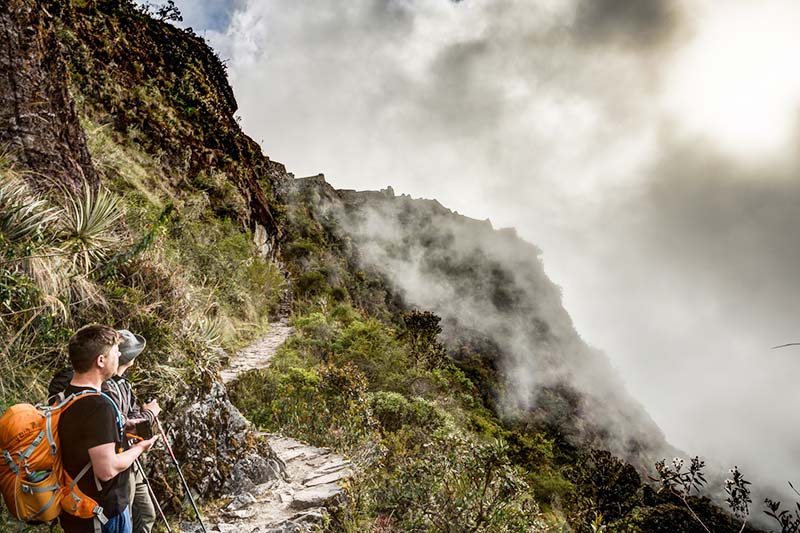
Inca Trail trails
Questions and answers about the availability of the Inca Trail 2025
-
1) How many kilometers is the Inca Trail?
The Inca Trail is a tourist route of 39 kilometers. This distance is covered in 4 days of walking and 3 nights of rest in camps.
-
2) Is the Inca Trail closed in 2025?
The Inca Trail remains open throughout 2025, except for February due to heavy rains.
-
3) Where does the Inca Trail start and where does it end?
The Inca Trail begins at kilometer 82 of the railway that connects Ollantaytambo with Aguas Calientes. The end is in Machu Picchu, after 39 kilometers of walking.
-
4) Is the Inca Trail available for all ages?
Yes. However, it is recommended that tourists enjoy this type of walk. Therefore, it is recommended that visitors are over 8 years old and under 65 years old.
-
5) How much does the Inca Trail tour cost?
The 4-day Inca Trail tour to Machu Picchu costs between 500 to 700 dollars for tourists approximately. This price varies according to the tourism agency you choose for your tour.
-
6) Is the Inca Trail dangerous?
No, the Inca Trail is a safe hike if all the instructions of the accompanying tour guide are followed. Do not take a detour off the route or approach the precipices.
-
7) Did the Incas build the Inca Trail?
Yes, the Inca Trail is a route that is part of the qhapac ñan, or royal Inca roads built during the time of Emperor Pachacutec (1418 – 1471).
-
8) How long in advance should I buy the Inca Trail tour?
The 4-day Inca Trail tour is highly requested by tourists from all over the world. Therefore, it is recommended to make the purchase online 6 or 7 months in advance.
-
9) Do Peruvians have discounts on the Inca Trail?
Yes, Peruvians have a special discount on the 4-day Inca Trail tour to Machu Picchu. Check the prices according to each tourism agency in Cusco.
-
10) With which tourism agency to do the Inca Trail?
In Cusco there are dozens of tourism agencies that offer the Inca Trail tour to Machu Picchu. Choose the one that fully complies with all its services offered. An excellent idea is to check the comments of other tourists in the internet tourism forums.
Advice from people who have been there
 By: Laura A.
By: Laura A.“The last day of the hike is spectacular!“
“To be honest, we only did the last stage of the walk, the short walk, so I can't talk about the rest of the tour, but what we saw was incredibly beautiful and interesting. We went through two very impressive archaeological sites and saw a waterfall. I'm not in great shape but I could do the hike quite easily, so I recommend everyone to do it. It's something that has to do with your own eyes. “
By Ticket Machu Picchu – Last updated, January 2, 2025
The post Are there spaces available for the Inca Trail 2025? first appeared on Ticket Machu Picchu.
]]>The post See Availability Inca Trail in real time first appeared on Ticket Machu Picchu.
]]>How to see the availability of the Inca Trail 2025?
To see the available spaces of the Inca Trail follow these steps:
- Choose the type of Inca Trail route you want to do: Classic Inca Trail (4 days) or Short Inca Trail (2 days).
- Choose the date (month and day) on which you want to do the Inca Trail.
- Check the number of spaces available for the date you want: ’30’ means that there are still thirty free spaces left.
- If there is still availability, click on the chosen date to begin the reservation process.
Official Inca Trail Calendar
Below we show you the official availability calendar of the Inca Trail 2025:
- How to book the Inca Trail tour?
- Why book the Inca Trail 2025 with Ticket Machu Picchu?
- What does a tour to the Inca Trail include?
- Prices and discounts of the Inca Trail
- How long before booking the tour to the Inca Trail?
- What is the short Inca Trail (2 days)?
- What to do if there is no availability for the Inca Trail?
- Questions and answers about the availability of the Inca Trail
- Photo gallery
How to book the Inca Trail tour?
Did you find availability for the date you want? Now you just have to make the reservation following these 4 steps:
- a) Complete the basic information of all visitors on the reservation form (names, age, email, nationality, document, document number).
- b) Make the payment using one of the 4 available methods: Visa, MasterCard, Diners Club or PayPal .
- c) Verify the payment receipt that you will receive in your email inbox.
Why book the Inca Trail 2025 with Ticket Machu Picchu?
- The Inca Trail 4 days is an All Inclusive Service that offers all the comforts for a safe and well organized adventure.
- The tour includes transportation, entrance to the Inca Trail, Machu Picchu, tour guide, camping equipment, porters, cooks, return by train and more .
- The tour also offers discounts for university students and children up to 11 years.
What does a tour to the Inca Trail include?
The tour to the Classic Inca Trail (4 days) includes the following:
- Entrance to the Inca Trail.
- Transportation from Cusco to the starting point to the Inca Trail.
- Bilingual tour guide service.
- Porter service
- Cook service (3 breakfasts, 3 lunches and 3 dinners).
- Camping equipment (does not include sleeping bag).
- Machu Picchu Solo entrance.
- Return by bus to Aguas Calientes.
- Return by train to Ollantaytambo.
- Return by minivan to Cusco.
In addition, the tourist can request the following extra services:
- Entrance to the Huayna Picchu mountain.
- 1 extra carrier.
- 1 sleeping bag
- Vegetarian food option at no extra cost.
Inca Trail Discounts
The Inca Trail offers discounts for tourists who are university students as well as minors.
- University students must study undergraduate and have less than 25 years at the time of the walk. The discount applies only to students with a valid university card (No ISIC card).
- Children (under 11 years old) also receive a special discount. Parents must make the reservation by sending their child’s passport or identity document.
How long before booking the tour to the Inca Trail?
In order to find availability on the Inca Trail it is necessary to make the reservation in advance.
- The Classic Inca Trail (4 days) must be booked 4 months in advance or more. Especially during the high tourist season (from April to October).
- The Short Inca Trail (2 days) must be booked 2 or 3 weeks in advance. Especially, during the high tourist season.
The high tourist season (from April to October) is the time of the year when more tourists visit Machu Picchu. That is why you need to book the Inca Trail well in advance.
What is the short Inca Trail (2 days)?
- The Short Inca Trail crosses a part of the Classic Inca Trail to reach Machu Picchu after 11 kilometers of walking.
- This route runs through the archeological sites of Chachabamba and Wiñayhuayna . Then he arrives at Intipunku and, finally, Machu Picchu.
- This short version only takes about half a day to reach the Inca City. The visit to Machu Picchu is the next day after spending the night in a hotel in Aguas Calientes.
- This short route has a capacity for 250 tourists per day . The tour starts at kilometer 104 of the Ollantaytambo – Aguas Calientes railroad.
- Unlike the classic Inca Trail; This short version does not need to be reserved months in advance. It is recommended to do it 2 or 3 weeks before.
What to do if there is no availability for the Inca Trail?
- Unfortunately, if there is no availability for a given date, you can only search for spaces on a different date. It is recommended to make the reservation months in advance.
- A good option is to choose the short Inca Trail. This adventure is ideal for people who do not have enough time or could not book the classic 4-day version.
- There are other incredible walks that lead to Machu Picchu such as: the 5-day Salkantay route, the 4-day tour of Lares and the incredible 8-day route Cusco – Choquequirao – Machu Picchu .
Questions and answers about the availability of the Inca Trail
-
1. Does the Inca Trail remain closed in February?
Yes. Due to the constant rains, maintenance personnel do conservation work on the Inca Trail route. That’s why all February, you can’t make reservations.
-
2. Why is it so difficult to find availability?
The Inca Trail has a historical value that is preserved by the authorities of Peru. Therefore, only 500 people are allowed to enter a day (200 tourists and the rest are support staff). The goal is to keep this tourist attraction for posterity.
-
3. Is there an official page to buy spaces to the Inca Trail?
No. You can only get availability for the Inca Trail through an authorized tourism agency. The agencies also offer a complete tour that includes the entrance to the Inca Trail, Machu Picchu and more.
-
4. Is it difficult to find availability for the Short Inca Trail?
No. The short version of the Inca Trail (2 days) allows 250 tourists per day to enter. Finding availability is not that difficult compared to the classic version (4 days). It is recommended to book online 2 or 3 weeks in advance.
-
5. Can I do the Inca Trail on my own?
No. The Ministry of Culture of Peru ordered that the Inca Trail can only be done through an authorized tourism agency. No tourist can enter the Inca Trail without the authorization of an agency.
-
6. Can children do the Inca Trail?
It depends. Children older than 8 years or who already have a satisfactory experience on similar walks, can do the Inca Trail. On the other hand, it is not recommended for children under 8 years of age who do not have a similar previous experience.
-
7. Can older adults do the Inca Trail?
It depends. Older adults who are physically well preserved can complete the Inca Trail. In the case of older adults with some recurring physical discomfort, they should consult their doctor.
Advice from people who have been there
 By: George B.
By: George B.“Inca dream!“
“The adventure along the Inca trail is unparalleled. I liked the landscapes and the animals. Good guy! not to mention the citadel of machupicchu“
By Ticket Machu Picchu – Last updated, January 2, 2025
The post See Availability Inca Trail in real time first appeared on Ticket Machu Picchu.
]]>The post The truth about the closure of the Inca Trail to Machu Picchu first appeared on Ticket Machu Picchu.
]]>- When does the Inca Trail to Machu Picchu close?
- Why does the Inca Trail close in February?
- So, how to get to Machu Picchu in February?
- How to reserve the income of the Inca Trail?
- Can I do the Inca Trail on my own?
- When is the best month to do the Inca Trail?
- Alternatives to the Inca Trail in February
- Machu Picchu closes in February?
- Huayna Picchu closes in February?
- Photo gallery
When does the Inca Trail to Machu Picchu close?
- The Inca Trail (the 4-day trekking route to Machu Picchu) remains closed to tourists during the month of February.
- The rest of the year, the Inca Trail is open to the public except in case of emergency.
- February brings with it the strongest rains of the season. So, regardless of whether it is the classic Inca Trail or its short version (2
days), it is impossible to do so in February.
En 2025, el Camino Inca a Machu Picchu cierra todo febrero. La venta de los permisos de ingreso para ese mes es prohibida. Sin embargo, el resto del año esta ruta de senderismo histórica está abierta para todos. Se recomienda hacer la compra hasta 5 meses antes de la fecha elegida. ¿La razón? Son muchos los turistas que quieren hacer esta caminata y pocos los espacios disponibles.
Why does the Inca Trail close in February?
- February is the rainiest month in Cusco and Machu Picchu. The institutions in charge indicate that “You will not be able to enter Machu Picchu by the Inca Trail in February.”
- The objective of this closure is not only to preserve the old Inca Trail but also for safety.
- During that month, conservation and maintenance works are carried out. The deteriorated parts of the road are repaired. The terraces and camping sites are arranged.
So, how to get to Machu Picchu in February?
- As you can see, entering Machu Picchu on the Inca Trail in February is impossible.
- If you only have free time to visit Machu Picchu in February, you will have to arrive by train through a 2 hour trip through the Sacred Valley.
- Another option is to get to Machu Picchu through the alternative route of Hydroelectric. This form is longer (lasts 7 hours approximately) but more full of adventure.
How to reserve the income of the Inca Trail?
- The sale of the entrance permits to the Inca Trail is only through the authorized tourism agencies.
- The purchase is online with time in advance.
- If you do not book tickets at least 6 months in advance, you can not get to Machu Picchu on the Inca Trail.
Can I do the Inca Trail on my own?
- The only way to do the Inca Trail is to hire the service with an authorized agency. There is no way to do it otherwise.
- You can book the Inca Trail for the whole year. Only in February you will have to get to Machu Picchu by train or by the hydroelectric route.
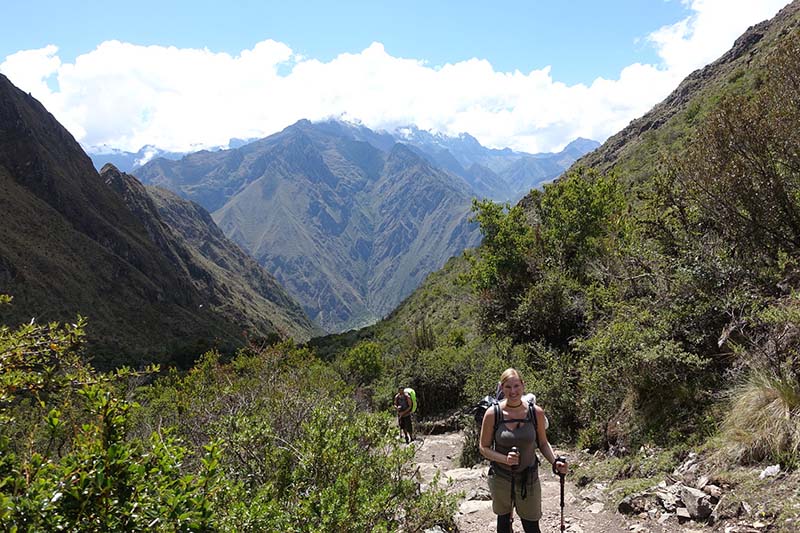
Inca Trail Trek – Machu Picchu
When is the best month to do the Inca Trail?
- The Inca Trail is wonderful throughout the year. However, the months of June, July, August and September have a more pleasant climate for walks.
- During those months, the rains are scarce. In addition, the sun is radiant in the mornings and afternoons. At night the cold makes it necessary to take shelter.
Alternatives to the Inca Trail in February
If you want to get to Machu Picchu walking in February, you can choose other incredible routes.
The Inca Jungle – Offers one of the most adventurous ways to get to Machu Picchu. It combines downhill biking, rafting, zip-line and hiking.
Salkantay trek – This alternative hike lasts 5 days. It crosses the imposing Salkantay mountain at 4,650 meters above sea level until reaching Machu Picchu passing through Aguas Calientes.
Lares Trek – This trek has many variations. The starting point is the town of Lares in Cusco. After 4 days of hiking, you will arrive at Machu Picchu.
Machu Picchu closes in February?
- Keep in mind that the closure of the Inca Trail in February does not affect visits to Machu Picchu in any way.
- The sale of tickets to the ‘Inca City’ does not close in February. Machu Picchu remains open all year except for some emergency situation.
Huayna Picchu closes in February?
- Like Machu Picchu, the Huayna Picchu mountain is open all year, including February.
- The Waynapicchu mountain is considered one of the best short walks in the world. Tickets must be purchased 3 or 4 months before.
Advice from people who have been there
 By: George B.
By: George B.“Inca dream!“
“The walk is an adventure like no other. I liked the landscapes and animals in their natural state. Recommendable! for people who like new experiences“
By Ticket Machu Picchu – Last updated, January 2, 2025
The post The truth about the closure of the Inca Trail to Machu Picchu first appeared on Ticket Machu Picchu.
]]>The post The Inca Trail to Machu Picchu – Among the best hikes in the world first appeared on Ticket Machu Picchu.
]]>The Inca Trail to Machu Picchu is considered one of the best hiking routes in the world. The main reason for this is that the route follows ancient traces, Inca ruins or constructions and also beautiful landscapes. The experience of the route is incomparable due to the cultural and natural wealth that thousands of adventurers who dare to do it have to offer. In this blog we do not only want to talk about the Inca Trail but also about other hiking routes that are also quite well known worldwide. For which we will also present a comparison table. Let’s get started!
- What are the best hiking trails in the world?
- What is the Inca Trail?
- Recommendations for hiking routes
- The best months to do the Inca Trail
- Comparisons of the Inca Trail and other hiking routes in the world
- Frequently asked questions about the Inca Trail
What are the best hiking trails in the world?
The world offers various experiences in contact with nature. Hiking trails are popular activities that thousands of tourists do in different places around the world. Thanks to the great variety of geographies, thousands of experiences can be found.
However, there are some routes that will stand out from others. In Peru we are blessed with a wealth of history, culture and adventure on the route to Machu Picchu via the Inca Trail. The other hiking routes in the world also have their own characteristics. Let’s look at some of them.
Annapurna trek, Nepal
- Rewarding route that lies between the mountains of the countries of China and India.
- The trek takes place in the Annapurna Conservation Area, which is located in the country of Nepal.
- You can see beautiful landscapes and contemplate the cultural wealth of the populations of the Himalayan mountain range.
- The best season to do the 15 or 20-day route is during the months of March, May and October, as well as the first days of November.
- The altitude can be reached close to 5,420 metres above sea level.
- You can cover up to 115 kilometers between different activities.
- The price is approximately 1422 USD.
W Circuit, Torres del Paine, Chile
- Extraordinary route in Chile, routes are made from Patagonia that belong to Chile.
- The hike takes place in Torres del Paine National Park, located in southern Chile.
- The ascent to the main viewing points of the Base of Las Torres and the Grey Glacier. Also the best views of rock formations.
- The best season to do the 4 to 5 day route is during the months of November to April.
- It reaches an altitude of 850 meters above sea level.
- You can cover up to 72 kilometres on a hiking route.
- The price is approximately 980 USD.
Samaria Gorge, Greece
- The Samaria Gorge is known for being the longest in Greece.
- A gorge runs through a deep, rocky depression. In the middle of the place you can see a river flowing by.
- The Samaria Gorge is located on the Omalós Plateau, bordering the country of Libya.
- The hike through the Samaria Gorge lasts approximately 6 hours. It is an all-day activity, including transportation.
- This route can be done from April to October. It is important to take into account the occasional rain.
- The activity takes place very close to the sea, so the altitude starts at 1200 meters above sea level until reaching the beaches.
West Highland Way, Scotland
- It is Scotland’s most famous route, surrounded by pure nature.
- The walk starts in Milngavie, via Glasgow and ends in Fort William, crossing Loch Lomond.
- Some people decide to do the route in the opposite way.
- You can enjoy beautiful scenery and views of Loch Lomond and the Loch Lomond and Trossachs National Park.
- The hike can be done in 5 days if you are an expert. But the recommended days are 8 days.
- The altitude reaches just 1,345 metres above sea level.
- It is a demanding route covering 154 kilometers of different terrains.
- The price is approximately between 890 and 1350 USD.
Yoshida Route, Mount Fuji, Japan
- Mount Fuji has different climbing areas. In this case we want to talk about the Yoshida route through Tokyo.
- Mount Fuji is a dormant volcano 3,776 meters high. It is the highest mountain or peak in Japan.
- This is a popular route, with the Yoshida route being the busiest. There are several shelters on the outward route, but almost none on the return route.
- The Yoshida route can be done from July 1 to September 10 , which is the ideal date to do so.
- The walking time is 6 hours and the descent time is 4 hours. It is important to follow the signs and not deviate.
- Many people make the ascent at night. You can only make the trek if you have a reserved shelter.
- The limit of people entering daily is 4000. This is in order to avoid crowds and garbage waste.
- The entrance fee alone is 13 USD, not including food, transportation and other expenses.
Hiking routes around the world have many differences.
Routes, trails and tourist destinations have different requirements and also bureaucratic details such as availability, prices and other requirements. Before doing one of these routes or any other, it is recommended that everyone properly find out each of the rules, recommendations and other details to make the hike without problems or last-minute surprises. By being properly informed you will also be able to make the appropriate contract with a travel agency to provide you with everything you need.
What is the Inca Trail?
These are several routes designed and built by the ancient inhabitants of the Peruvian territory. It is believed that the Incas adopted and improved several of the routes that were part of their domain.
This is why Inca Trails can be found in Ecuador and Colombia, all the way to Chile and northern Argentina. Many of these trails have been reused today to become highways or similar.
The Inca Trail to Machu Picchu offers a route full of culture, history and beautiful landscapes. The hike begins in Piscacucho, a small campsite for all tourists to begin their hike.
Today, the Inca Trail to Machu Picchu is recognized worldwide precisely for its attractions , it allows you to see archaeological sites, lush landscapes and an impressive change of geography upon reaching the Inca citadel. This route can be done in 4 days, with the fourth day being the day when you visit Machu Picchu and you can return to Cusco by train.
Recommendations for hiking routes
- To do any hiking route in the world, you must find out the weather conditions.
- Find out the entrance fee or ticket payment that must be made.
- Likewise, find out if the route to be followed has an entry limit or limited capacity, in order to make the reservation in advance.
- Check the number of days you will be hiking. This is to pack only what is necessary.
- It is important to maintain good physical condition to enjoy the walk and not suffer from it.
- Wearing hiking shoes must offer safety and comfort when hiking.
- Consider the best seasons to visit each destination. The tourist’s experience often depends on these details.
- If you are going to hike at more than 2000 meters above sea level, prior acclimatization of at least 2 days is recommended, depending on the intensity of the route.
The best months to do the Inca Trail
An example to consider can be seen on the Inca Trail route to Machu Picchu. In Cusco and much of southern Peru, there are two well-defined seasons. The first is the dry season and the second is the rainy season.
The dry season begins in May and lasts until the first days of November when the first rains begin. This will be the best season to make the journey to Machu Picchu and have one of the best experiences of the adventure.
However, during the rest of the months, from November to April, there may be some rain. The month with the most rain will be February and only during that month the Trail to Machu Picchu cannot be done. During the rest of the months of the rainy season it is possible to do so.
This is how you can have a different experience. The rains may seem like an obstacle, but for some it is the opportunity to do the route with new challenges and challenges. If you plan to do the route during this season, bring a poncho and waterproof shoes to enjoy the experience.
Comparisons of the Inca Trail and other hiking routes in the world
| Hiking trails | Location | Duration | Difficulty | Main attractions | Best time to visit |
|---|---|---|---|---|---|
| Inca Trail to Machu Picchu | Peru | 4 days | Moderate High | Follow the Inca Trail, where you can see several Inca sites and buildings, most notably Wiñayhuayna and Machu Picchu. | From May to October. |
| Annapurna Trail | Nepal | 15 to 20 days | High | Beautiful views of the Himalayas. Experience Nepalese culture. Beautiful landscapes throughout the trek. | From May to October. |
| West Circuit. Torres del Paine | Chili | 5 to 7 days | Moderate High | Visit the Mirador Base Las Torres and the Grey Glacier, part of the Valle Frances and rock formations. | It is best to do the tour from November to April. |
| Samaria Gorge | Greece | 1 day | Moderate | The Omalós plateau, pine, plane and cypress plantations, as well as the entrance or “Iron Gates”. | It is best to do the tour from November to October. |
| West Highland Way | Scotland | 6 to 8 days | Moderate | Beautiful scenery and views of Loch Lomond and the Loch Lomond and the Trossachs National Park. | The best months to visit are from April to October. |
| Yoshida Route, Mount Fuji | Japan | 1 to 2 days | High | You can see some of the ancient temples and also views of the cities surrounding Mount Fuji. | From July 1st to September 10th. Open months. |
Frequently asked questions about the Inca Trail
-
When to book the Inca Trail?
As we mentioned before, we are talking about one of the best treks in the world and you should normally book 8 months in advance, so you can choose the days you want to walk the Inca Trail to Machu Picchu. If you make your last minute reservation you may find some tickets available up to 3 months in advance. If you want to come during the high season (May – August) we recommend booking a space on the Inca Trail 12 months in advance.
-
When is the best time to go?
The best time to walk the Inca Trail to Machu Picchu is undoubtedly during the dry season, from April to September. Although you can also come during the rainy season, you will not be able to enter during the month of February, which is the month with the heaviest rains and the trail is closed for conservation. In addition, this time is used to maintain all sections of the trail. Remember that the high season (May to August) coincides with the dry season, and you have to book your entry well in advance.
-
Why choose us?
Well, if you already know that you cannot travel the Inca Trail without hiring an agency, you should know that you should not only choose us for our high quality of service, because although it is our priority, the constant search to raise our standards as a company means that behind your trip there is an incredible group of people, committed to you, to your work and to everything that involves operating the Inca Trail to Machu Picchu.
-
About altitude sickness?
No matter your age, physical condition or where you come from, anyone can get altitude sickness. The highest point you will cross while hiking the Inca Trail is at 4,125 meters above sea level, at a place called Dead Woman’s Pass, at which altitude you run the risk of experiencing symptoms of altitude sickness (acute mountain sickness). But don’t panic, there are ways to avoid the symptoms of altitude sickness, and our experienced guides know what to do in any circumstance.
-
2-day Inca Trail?
Yes, there is a 2-day Inca Trail; it is for people who do not have the time available to hike the classic Inca Trail (4 days), but also for those who want to skip the most difficult part of the trek.
Advice from people who have been there
 By: Juan P.
By: Juan P.“One of the best hikes in the world?“
“Many people told me that it would be one of the best experiences of my life, that it was one of the best hikes in the world, and I believed it until I was there. Now I am completely sure that it is not only one of the best, it is one of those experiences that every person should have at some point in their life.“
By Ticket Machu Picchu – Last updated, December 31, 2024
The post The Inca Trail to Machu Picchu – Among the best hikes in the world first appeared on Ticket Machu Picchu.
]]>The post Inca Trail, route to the Inca City of Machu Picchu first appeared on Ticket Machu Picchu.
]]>- The roads of the Inca ( Qhapac Ñan )
- The Inca Trail to Machu Picchu
- Versions of the Inca Trail to Machu Picchu
- How is the tour of the Inca Trail to Machu Picchu?
- And how is the tour of the Short Inca Trail (2 days)?
- Difference Inca Trail 4 days and 2 days
- About tickets to enter the Inca Trail
- Inca Trail – Photo Gallery
- When is the best time to travel the Inca Trail to Machu Picchu?
- What to take to the Inca Trail?
- How much does the Inca Trail cost?
- Recommendations on the Inca Trail to Machu Picchu
- Salkantay, Choquequirao and other incredible treks to Machu Picchu
- Questions and answers about the Inca Trail route to Machu Picchu
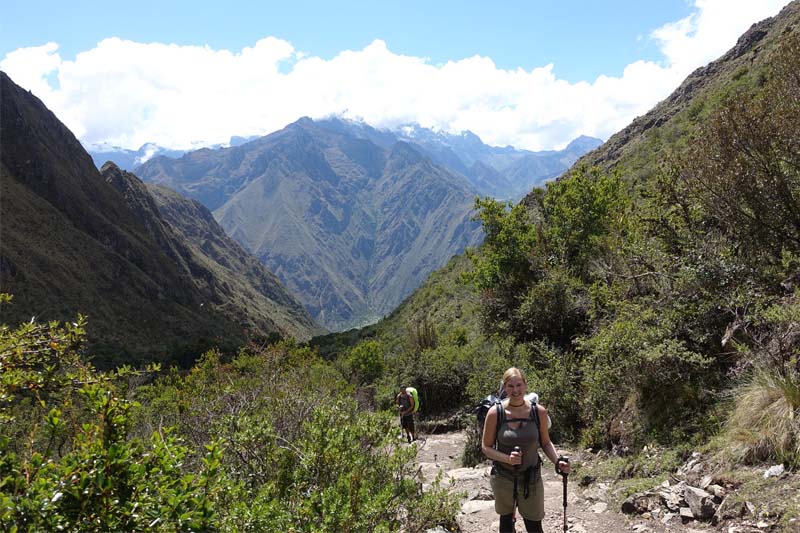
The incredible Inca Trail, the most spectacular hiking route in South America
The roads of the Inca (Qhapac Ñan)
The Incas encompassed much of the South American continent. To maintain communication in such a vast territory it was necessary to build a network of roads. Thus, the Inca ordered to build a network of roads called Qhapac Ñan (Camino del Inca).
The Qhapac Ñan were able to cover up to 30 thousand kilometers from the current countries of Peru, Ecuador and part of Bolivia, Chile, Argentina and Colombia. The hiking route of the Inca Trail to Machu Picchu is only a small part of the extensive road network of the Qhapac Ñan.
The Inca Trail to Machu Picchu
The Inca Trail was revealed to the world in 1915 when it was being excavated in the Inca City. Three decades later, the route was traced by the Viking expedition in 1942. Today, thousands of visitors decide to travel the 43 kilometers to the ‘Puerta del Sol’ in Machu Picchu.
However, Machu Picchu is not the only archaeological site you will see on the Inca Trail. In the tour you will also appreciate the ruins of Llactapata, the archaeological site of Runkurakay, Saycamarca, Phuyupatamarca and Wiñaywayna.
There are trains and buses that can take you directly to Machu Picchu. However, the experience of arriving as the Incas did during centuries is unmatched.
Versions of the Inca Trail to Machu Picchu
Not all people have the necessary days to travel the Inca Trail (4 days and 3 nights). That is why there are 2 versions depending on the time that is counted:
- Classic Inca Trail: 4 days and 3 nights (43 kilometers of hiking).
- Short Inca Trail: 2 days and 1 night (12 kilometers of walk).
How is the tour of the Inca Trail to Machu Picchu?
The Inca Trail shows rugged geographies with ascents and descents on the side of precipices. The mountains reach great heights with uneven stretches. In the jungle areas you will see the variety of tones of green tropical forests.
-
Day 1: Cusco – Wayllabamba (13 kilometers)
The Inca Trail begins at kilometer 82 of the railway that leads to Machu Picchu (2 hours and 30 minutes by bus from the city of Cusco). Then the ascent to the valley of Cusichaca will begin. The visitor will visit the ruins of Llactapata (2,840 masl) until reaching the town of Huayllabamba (3,057 masl).
-
Day 2: Wayllabamba – Pacaymayo (11 kilometers)
The second day is the most difficult due to the physical demand. The tourist will ascend to the Warmiwañuska (‘Passage of the dead woman’). This is the highest point of the route (4,215 meters above sea level). From this point it is possible to see the archaeological site of Runkurakay (3,760 masl).
-
Day 3: Pacaymayo – Wiñay Huayna (16 kilometers)
On the third day, the descent will be vertiginous to the valley of the Pacaymayo river. The section goes down a stepped slope of almost 1, 600 meters to the site of Sayaqmarca (3.625 masl). Here the view is extraordinary.
-
Day 4: Wiñay Huayna – Machu Picchu (3 kilometers)
The last day hides some of the best Inca exhibitions: Phuyupatamarka, Wiñaywayna. When leaving these ruins, a gradual descent will be undertaken that will become more complicated in the end. Finally, you will arrive at the Intipunku or Puerta del Sol. From there you will walk for another 30 minutes to the Lost City of the Incas, Machu Picchu.
After visiting Machu Picchu, the visitor returns to Cusco through a train and bus service. The duration of the trip is approximately 3 hours. These services are included in the tours to the Inca Trail.
During the 4 days of the Inca Trail you will experience tiredness and very low temperatures (between the Andes Mountain Range and the Amazonian forests).
And how is the tour of the Short Inca Trail (2 days)?
The short Inca trail is easy. It only travels approximately 11 kilometers. The first part is uphill so it is the most difficult. Once at the archaeological site of Wiñay Huayna, the path becomes easier. The entrance to Machu Picchu, like the Classic Inca Trail, is through the Puerta del Sol.
-
Day 1: Cusco – Km. 104 – Aguas Calientes (11 kilometers)
The Short Inca Trail begins at kilometer 104 of the Ollantaytambo – Machu Picchu railway (2 hours 45 minutes from the city of Cusco by car). From there you ascend through tropical landscapes (11 kilometers) until you reach the archaeological site of Wiñay Huayna from where you continue until you reach Machu Picchu.
-
Day 2: Aguas Calientes – Machu Picchu
Tourists will not visit Machu Picchu until day 2 when they depart by bus from their hotel in Aguas Calientes to the entrance gate to Machu Picchu. Finally, you will get to know the Inca City together with your tour guide. The return is by train and bus to the city of Cusco.
Difference Inca Trail 4 days and 2 days
| Differences | Inca Trail 4 days | Inca Trail 2 days |
| Distance | 39 kilometers | 11 kilometers |
| Difficulty | Moderate – High | Moderate |
| Max Height | Abra Warmiwañusca (4,215 masl). | Intipunku (2,745 masl). |
| Minimum height | Aguas Calientes (2,040 masl). | Aguas Calientes (2,040 masl). |
| Campsite | 3 nights of camping | 1 night in a hotel in Aguas Calientes |
| Feeding | Cooks (3 breakfasts, 3 lunches and 3 dinners) | 1 box lunch as well as 1 dinner and 1 breakfast (in a restaurant) |
| Guide | 4 days professional guide | Professional guide 2 days |
| Porters | It does include 3 days of porters | Does not include the porter service |
| Archaeological Sites | Llactapata, Runkurakay, Sayacmarca, Phuyupatamarca, Wiñayhuayna and Machu Picchu | Chachabamba, Wiñayhuayna and Machu Picchu |
| Price (approximate) | 600 USD | 500 USD |
About tickets to enter the Inca Trail
Due to the high demand for tickets, you must get entry tickets to the Inca Trail a long time in advance (6 months). The purchase is made only through the Internet through the website of an authorized tourism agency.
In total 500 people enter the trails of the Inca Trail every day. Of them, only 200 are tourists. The rest is support personnel such as cooks, porters, guides. The ticket to enter the Inca Trail includes the support staff.
Did not find availability to do the Inca Trail? The only way to enter the Wonder of the World is by train through the Sacred Valley of the Incas or through the alternative route from Santa María to Machu Picchu. Entrance tickets to Machu Picchu must also be reserved in advance.
Do you want to enter Huayna Picchu after the Inca Trail? Request entry into the agency paying an extra price. You can also request a more luxurious train service.
When is the best time to travel the Inca Trail to Machu Picchu?
From May to September (dry season) is the ideal time to travel the Inca Trail to Machu Picchu. These months are usually good for the crossing due to the low frequency of rains.
In the months of November to March the summer (rainy season) occurs. This time is usually very rainy, which makes walking and access difficult. Even, it will not be able to cross the Inca Trail in February due to the precipitations and works of maintenance.
What to take to the Inca Trail?
The Inca Trail includes basic items such as: personal tent, tent for the kitchen, insulating mattress, food (breakfast, lunch and dinner), among others.
To enjoy the best way this adventure is recommended, in addition, carry the following:
- Sleeping bag.
- Walking stick.
- Backpack for trekking.
- Sunglasses.
- Poncho for the rain.
- Bottle of water.
- Water purifier.
- Toilet paper.
- Snacks.
- Cleaning items.
How much does the Inca Trail cost?
The prices of the Inca Trail vary according to each tourist agency. The services that are included are: entrance to the Inca Trail, access to Machu Picchu, official tourist guide, transportation, food and porters (one per person).
The average cost of the Inca Trail is the following:
| INCA 2025 ROAD PRICES | ||
| Classic Inca Trail (4 days) | Short Inca Trail (2 days) | |
| Adult prices | 600 U$D | 500 U$D |
| University student prices | 580 U$D | 480 U$D |
| Prices under 18 years | 580 U$D | 480 U$D |
*Prices are averages and are in US dollars.
Recommendations on the Inca Trail to Machu Picchu
- The Inca Trail runs through high Andean landscapes where the ‘altitude sickness’ or ‘soroche’. is manifested . It is recommended to spend 1 or 2 days in the city of Cusco to acclimatize.
- During the 4 days of the Inca Trail there is no electricity or telephone network. If the visitor needs to be ‘connected’, he must take precautions.
- The hygienic services are camps conditioned for that purpose.
- The classic Inca Trail consists of groups composed of a maximum of 16 people. If the visitor wishes to take a tour with a private group, they must request it online in advance. This service has an additional cost.
- The Inca Trail is considered to be of medium moderate difficulty. It is advised to be in an acceptable physical condition. A previous week of exercises will be enough.
- If you do not get availability for the Inca Trail, you can choose to get to Machu Picchu through the Salkantay route.
Salkantay, Choquequirao and other incredible treks to Machu Picchu
The Inca Trail is not the only trekking route that takes several days to reach Machu Picchu. There are also other very famous ones such as: the Salkantay Trek, the route to Choquequirao or the Lares Trek.
The Salkantay Trek
- A hiking route of 5 days and 4 nights (it can vary to 4 days and 3 nights) that runs through the landscapes of the snowy Salkantay.
- The trek is more difficult than the Inca Trail. This is mainly due to the high-altitude landscapes it traverses. The ‘Abra Salkantay’ (4,6450 m.a.s.l.) is the highest point of the trek.
- Access to Machu Picchu is through the town of Aguas Calientes. This walk can be done on your own, although it is best to hire a tour.
The Lares Trek
- A hiking route of 4 days, 3 nights that crosses Andean towns with a lot of tradition as well as the town of Lares, famous for its thermo-medicinal baths.
- This trek is easier than the Inca Trail. The last part of the trip includes a train ride from Ollantaytambo to Aguas Calientes and from there to Machu Picchu by bus.
- The Lares Trek can be done on your own. However, it is best to do it with a tourism agency.
The Choquequirao – Machu Picchu route
- An extreme excursion of 8 days and 7 nights that goes to Machu Picchu along a route that includes a visit to the archaeological site of Choquequirao (known as the sacred Sister of Machu Picchu).
- This adventure has a high difficulty. Few tourists dare to travel this route. Access to Machu Picchu is through Aguas Calientes, the town located at the foot of the Inca City.
- This route can only be done with a tourism agency due to the danger of getting lost in the mountains.
Questions and answers about the Inca Trail route to Machu Picchu
-
1) How many kilometers is the Inca Trail to Machu Picchu?
The route of the Inca Trail to Machu Picchu lasts 4 days and 3 nights of camping. It covers 39 kilometers in total.
-
2) Can I see Inca archaeological sites on the route?
Yes, during the walk you can see different Inca archaeological sites. Highlights: The Llactapata archaeological site, the Runkurakay archaeological site, the Sayacmarca archaeological site, the Phuyupatamarca archaeological site and the Wiñayhuayna archaeological site.
-
3) Where does the Inca Trail start?
The route begins at kilometer 82 of the train track that connects the town of Ollantaytambo with the town of Aguas Calientes.
-
4) Can I do the Inca Trail alone?
No, the Inca Trail route can only be done with the permits granted by the Peruvian Ministry of Culture. The tourist must contract a tour with a tourism agency, which is in charge of processing the permits and everything necessary for the adventure.
-
5) Is the Inca Trail safe?
Yes, the route has signs and surveillance points. It is recommended to follow the instructions of the tour guide for a safe adventure
-
6) Can everyone complete the Inca Trail?
The route is suitable for all people. However, it is recommended that children over the age of 8 who like hiking. Seniors must be in good physical condition.
-
7) Does the route close at any time of the year?
Yes, the Inca Trail route closes the entire month of February due to heavy rains and maintenance work on the site.
-
8) Does the route to Machu Picchu include camping nights?
The entrance to the Inca Trail is included in the tours. Tours cost approximately $600 per person. It also offers everything you need for the adventure, including the entrance to Machu Picchu.
-
9) How much does it cost to enter the Inca Trail to Machu Picchu?
The entrance to the Inca Trail is included in the tours. Tours cost approximately $600 per person. It also offers everything you need for the adventure, including the entrance to Machu Picchu.
-
10) What does the tour to the Inca Trail to Machu Picchu include?
All tours to the 4-day Inca Trail include: permits for the route, full transportation, professional guide, team of cooks, team of porters, camping utensils, entrance to Machu Picchu and return to Cusco.
By Ticket Machu Picchu – Last updated, December 30, 2024
The post Inca Trail, route to the Inca City of Machu Picchu first appeared on Ticket Machu Picchu.
]]>The post Inca Trail to Machupicchu: 5 best treks in the world first appeared on Ticket Machu Picchu.
]]>The leisurely pace of hiking is for many the best way to see the world. The routes that we will describe below demand a lot of effort and desire to reach the end of the trail. Many people talk about the Inca Trail to Machu Picchu as the best hike in the world, however, all of them will require some courage and effort, but the end of any of them will make it all worthwhile. Any of these 5 trekking routes will give you the opportunity to see beautiful landscapes and in some cases impressive constructions of ancient cultures, in the middle of the most incredible natural environments that exist.
- The Inca Trail to Machu Picchu in Peru
- Route to Everest base camp in Nepal
- Route to the Dogon ethnic group in Mali
- Trekking the GR20 in France
- Trek to the Himalayas in India
- Questions and answers about the best treks in the world
The Salkantay trek 5 days, the other great trekking route to Machu Picchu
Undoubtedly the Inca Trail is the most famous trekking route in Machu Picchu. It is a hike of 70 kilometers in 5 days and 4 nights through the beautiful landscapes of high mountain and high jungle of Cusco. It includes visits to incredible landscapes such as the Humantay lagoon, the archaeological site of Llactapata or the thermal baths of Aguas Calientes. On the fourth day you will arrive to the town of Aguas Calientes to visit Machu Picchu the following day. Unlike the Inca Trail, this route is free access. You can do it with a tour or on your own.
The Inca Trail to Machu Picchu in Peru
- It is possible that the Inca Trail is the best hike in the world, and although there has never been a survey to determine this, it is enough to see the comments of thousands of people on the internet.
- When we talk about the Inca Trail, we are not only talking about a path in the middle of nature, we are talking about a path laid out by the Incas more than 500 years ago, in perfect harmony with the natural environment in which it was built.
- The Inca Trail covers 39 kilometers that will take you through incredible mountain passes of the Andes Mountains, up to a cloud forest in the Amazon jungle; but on this trekking route you will not only see amazing mountains, turquoise lagoons, trails next to impressive cliffs and mighty rivers, but also some of the most amazing Inca and pre-Inca constructions.
- When you think you are too tired to continue you will reach the Sun Gate, and from there you will have your first view of the city sacred to the Incas and one of the world’s top destinations, but Machu Picchu has its own post.
- You will arrive in the city of Cusco and travel through the beautiful Sacred Valley of the Incas to reach the start of the Inca Trail, which begins at kilometer 82 of the railway to Machu Picchu, a short distance from the town of Ollantaytambo.
Route to Everest base camp in Nepal
- This trekking route covers approximately 145 kilometers in 15 days of trekking. The trek takes place on the borders of Nepal and China in the Himalayas.
- It is not a route for everyone, but those who dare and can resist the ascent to 5,545 meters above sea level.
- You will be able to show off your photo on Facebook at the highest base camp in the world, Kala Pattar.
- But as it is one of the best, it is also one of the most difficult, you will cross difficult and risky terrain between snowy valleys.
- It is likely that you will come across a Sherpa caravan, in one of the more than 20 days that the Everest trek lasts. The Sherpas are the ethnic group that inhabits these regions of Solu and Khumbu and those who will make it possible for you to trek Everest.
Route to the Dogon ethnic group in Mali
- This trekking route covers about 52 kilometers through beautiful landscapes of Africa, passing through the Badiagara fault where the Dogon people are known. The route can vary from two to ten days.
- The Dogon country is an African region in the nation of Mali, inhabited by “the Dogon”, one of the most interesting ethnic groups on the African continent.
- You will be able to see the cosmovision of this people reflected in their masks, their dances, their totemic sculptures made of wood and in their extraordinary architecture, which you will not be able to see until you stand in front of it.
- The Dogon are mimicked in the cliffs of Bandiagara, to walk their lands requires a good physical condition.
- You will feel the adrenaline flowing through your body, as climbing is the only way to reach certain parts of the Dogon lands.
- But if you are one of those who want to travel the world a little at a time, you can opt for one of the short tours of 2 days, but if you really want to enjoy the land of the Dogon and the Dogon country, you can do the tour of 10 days.
Trekking the GR20 in France
- With the more than breathtaking views of Corsica and the Mediterranean Sea in the background, the world-renowned GR20 is undoubtedly one of the most exciting hikes in the world, but also one of the most difficult.
- The long distance footpath ‘GR’ is a network of paths in Europe, where a large part of the paths are in France. In addition, there are trails in regions of Spain, Belgium, the Netherlands and more.
- Its trails cover more than 160 kilometers and it takes about 15 days to cross the beautiful forests, lakes and incredible geological formations.
- Its beautiful geography will provide you with the best “lunar landscapes” that you will be able to take in the whole world, within its route you will have to overcome rocky areas, steep slopes in many places.
- But every elevation you overcome will be a delight for your eyes, with some of the most breathtaking views of the Mediterranean Sea and the coasts of Corsica.
Trek to the Himalayas in India
- The Himalayas are called the roof of the world; there are only 14 mountains that exceed 8,000 meters in height and ten of them belong to the mountain system known as the Himalayas.
- It is the highest mountain range in the world and could not be missing among the best hiking routes. It is one of the most interesting destinations for people from all over the world, at least for those who believe they can make the journey through one of the most incredible mountain ranges that exist.
- The ideal tour starts in Spiti and ends in Ladakh, is known as Himachai Pradesh, lasts 24 days and follows the ancient trade routes used by the people who inhabited this region.
- The route passes through incredible landscapes and Tibetan culture full of culture. The highest point is the 5,578 meters above sea level pass, Khibber Gorge and more.
- People from all over the world have an obsession with these mountains, but this is not difficult to understand, just look at some images of these amazing mountains.
Questions and answers about the best treks in the world
-
1) What are the 5 best treks in the world?
Besides the Inca Trail to Machu Picchu, the best trekking routes in the world are: the route to Everest base camp in Nepal, the route to the Dogon ethnic group in Mali, the GR20 trek in France and the route to the Himalayas in India.
-
2) How far is the Inca Trail to Machupicchu?
This trekking route in Cusco, Peru, covers 39 kilometers on average.
-
3) What places can you visit on the Inca Trail to Machu Picchu?
During the Inca Trail to Machu Picchu the visitor can visit the network of Inca trails (qhapac ñan), as well as Inca archaeological sites such as: Runkurakay, Sayacmarca, Phuyupatamarca, Wiñayhuayna, the Intipunku (Sun Gate) and, of course, Machu Picchu.
-
4) Where does the Inca Trail start and end?
The starting point is kilometer 82 of the railroad to Machu Picchu (near the town of Ollantaytambo) and the ending point is Machu Picchu.
-
5) What is the maximum altitude on the Inca Trail to Machupicchu?
The highest point of the trek is at the pass of the dead woman, Wariwañusca in Quechua language. This point is 4,215 meters above sea level.
-
6) Is the Inca Trail to Machupicchu suitable for people of all ages?
Yes, the trail is suitable for visitors of all ages. However, it is recommended that children be older than 8 years old and that they enjoy hiking outdoors. Older adults should be in good physical condition, especially of the heart.
-
7) What is the climate like on the Inca Trail to Machu Picchu?
The climate is temperate with maximum temperatures of 23ºC. and minimum night temperatures of 6ºC. The rainiest days are in December, January and March. The Inca Trail is closed in February.
-
8) Is the Inca Trail to Machupicchu suitable for children?
It is recommended that children be older than 8 years old and that they enjoy hiking outdoors.
-
9) Can I do the Inca Trail to Machupicchu alone without a tour?
No, due to the fact that it goes through historical trails protected by the Peruvian State, this trekking route can only be done with an authorized tour agency. You can hire your tour online. It is recommended to do it 4 or 5 months in advance.
-
10) Can I do the Inca Trail to Machu Picchu all year round?
The Inca Trail is closed in February. Except for this month, the trail is available all year round.
Advice from people who have been there
 By: Carola H.
By: Carola H.“Only“
“We went through the Sacred Valley to Ollantaytambo, from there we boarded the train to kilometer 104, to undertake one of the most incredible experiences of our lives. On the way you can see Inca ruins in excellent condition, but the end is magical, maximum, delicious, the cherry on the mountain cake is given by the jewel of Machu Picchu.“
By Ticket Machu Picchu – Last updated, November 13, 2024
The post Inca Trail to Machupicchu: 5 best treks in the world first appeared on Ticket Machu Picchu.
]]>The post Climbing Huayna Picchu after doing the Inca Trail? first appeared on Ticket Machu Picchu.
]]>There are two adventurous alternatives par excellence in the Wonder of the World: the first is the amazing 4-day trekking route to Machu Picchu known as the Inca Trail. The second is the ascent to the top of Huayna Picchu mountain, considered one of the most incredible short hikes in the world. Many tourists, after living the experience offered by the Inca Trail want to experience the adrenaline of the Waynapicchu. Is this possible? Here is a guide to experience the two most incredible alternatives of the Inca Citadel.
- The Inca Trail
- The Huayna Picchu
- Climbing Huayna Picchu after the Inca Trail?
- Recommendations
- Other adventurous alternatives
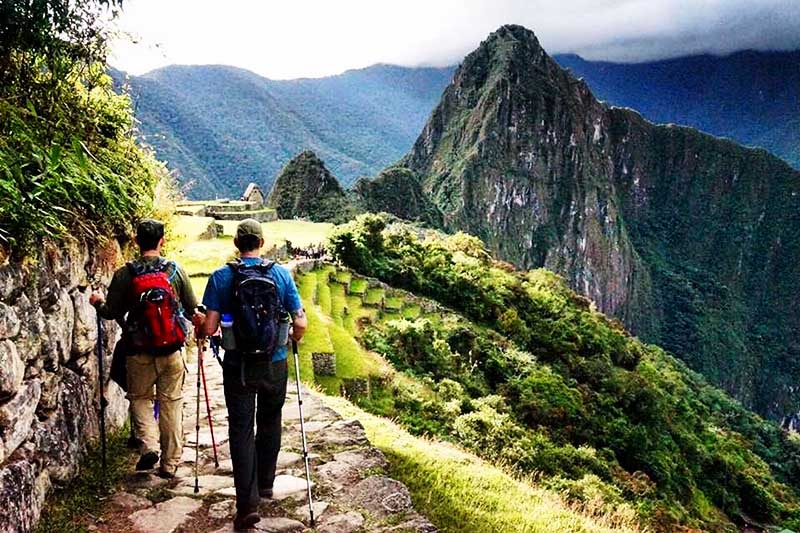
View of the Huayna Picchu mountain after hiking the Inca Trail
To visit Huayna Picchu Mountain after the Inca Trail, it is recommended to book the Machu Picchu + Huayna Picchu Ticket in Group 2. For both adventures, entrance tickets must be booked up to 6 months in advance.
The Inca Trail
The Inca Trail is a trekking route of 4 days and 3 nights to reach the Inca Citadel of Machu Picchu through the Sun Gate or Intipunku. In total, the route is approximately 43 kilometers through the ancient network of roads built by the Incas more than 600 years ago.
The adventure begins in the town of Pisqacucho, a small village in the middle of the railroad that leads to Aguas Calientes or Machu Picchu town. From there, the visitor travels through places at the foot of imposing snow-capped mountains such as the Warmihuañusca pass at 4,200 meters above sea level. As you descend, you will reach places with flora and fauna typical of the subtropical region that precedes the arrival to the Wonder of the World. On the fourth day, around 8:00 a.m., the visitor finally arrives at the Inca site.
It is estimated that 25,000 tourists hike the Inca Trail each year. It is not possible to do it on your own. To experience this adventure, it is necessary to reserve an entrance fee up to 6 months in advance. The 4-day hike includes an official tour guide, food, lodging in camps and porters who carry the tourist’s luggage on their backs. The Inca Trail is considered among the 5 best trekking routes in the world.
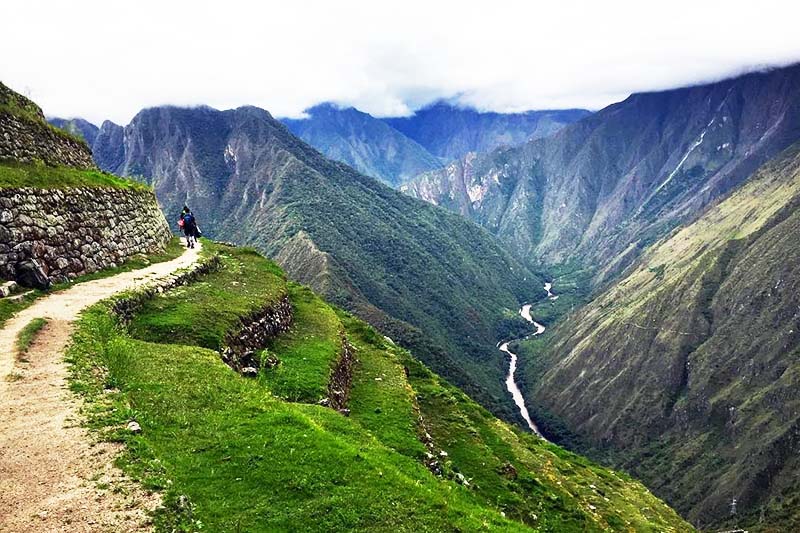
Section of the Inca Trail that leads to Machu Picchu
The Huayna Picchu
Huayna Picchu is the summit located north of the Inca citadel of Machu Picchu. It is located at 2,720 meters above sea level, almost 300 meters above the Inca site. It is known as the ‘young mountain’, as opposed to the Machu Picchu mountain (old mountain). The ascent to the top of this summit is considered one of the most incredible short hikes in the world.
The entrance gate to Huayna Picchu is located inside and to the north of the Inca Citadel. Ancient Inca trails lead to the top of this vertical mountain. The ascent is popular because of the adrenaline rush tourists experience as they climb the difficult and steep Inca trails on the edge of frightening cliffs. From the top of Waynapicchu, the splendor of the landscape surrounding the Wonder of the World can be appreciated. In the mountain of Huayna Picchu, you can also find the Temple of the Moon, this enclosure can be reached by following the descent route. In addition, you can only do this route with the Machu Picchu + Temple of the Moon ticket.
The only way to enter Waynapicchu is by booking the Machu Picchu + Huayna Picchu Ticket. This ticket allows the entrance of only 400 people per day so it is recommended to book tickets months in advance. Visitors can enter the mountain in two groups or schedules:
- Group 1: Enter Machu Picchu between 07:00 a.m. and 07:45 a.m. (Visitors can stay at the Wonder of the World until 01:00 p.m.)
- Group 2: Enter Machu Picchu between 09:00 a.m. and 09:45 a.m. (Visitors can stay in the Wonder of the World until 02:00 p.m.)
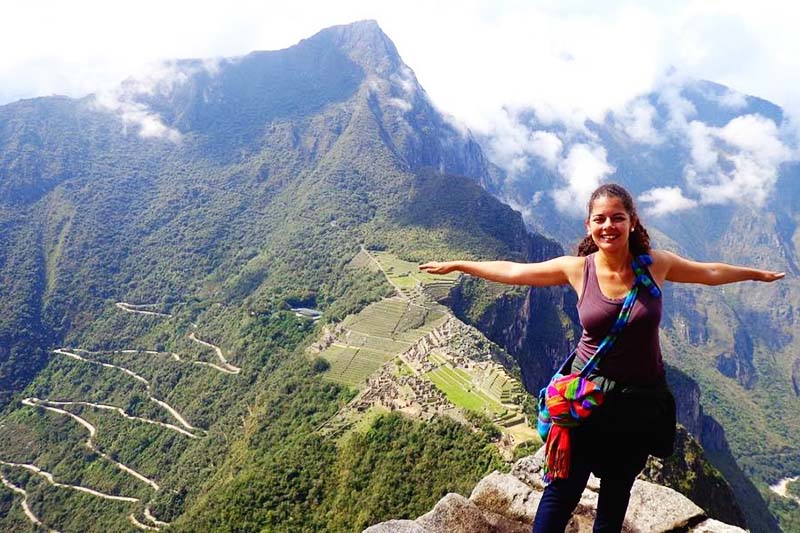
At the summit of Huayna Picchu
Climbing Huayna Picchu after the Inca Trail?
Visitors who wish to climb the Huayna Picchu mountain after the Inca Trail you must book the entrance ticket Machu Picchu + Huayna Picchu in schedule 2 (entrance from 9:00 to 9:45 for Machu Picchu). It is important to take the second schedule because when you arrive at Machu Picchu after following the route of the Inca Trail, you will need some time to rest and start the tour again, but this time with the route to Huayna Picchu that also follows the paths of the Qhapac Ñam.
To do both the Inca Trail and the ascent of Huayna Picchu mountain, a lot of planning is needed. The first thing to do is to make both reservations months in advance, especially if you plan to do the adventure during the high tourist season (April to October). If you plan to visit during the low tourist season (October to March), you should keep in mind that the Inca Trail is closed for maintenance throughout the month of February.
Visitors who enter the Huayna Picchu mountain through Group 2, can stay until 02:00 pm. in the Inca site. This provides the opportunity to have time to visit the stone constructions of the Inca Citadel, such as the Temple of the Condor, the Temple of the Sun or the Intihuatana. If there is not enough strength left to continue walking through the Wonder of the World, another option is simply to enjoy the incredible view that Machu Picchu offers.
The high season in Machu Picchu is now official. That is to say, during a period of time you will be able to access to more availability and also to new entrance tickets for other destinations. Among the destinations that can be found in the high season, we can find:
- Machu Picchu + Temple of the Moon
- Machu Picchu + Inti Punku
- Machu Picchu + Inca Bridge
- Machu Picchu + Huchuy Picchu
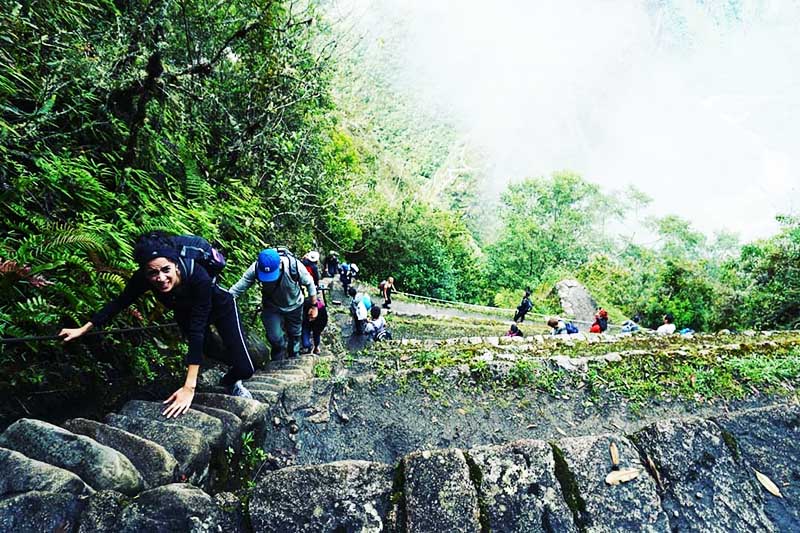
Tourists climbing the Huayna Picchu mountain
Recommendations
- Before doing the Inca Trail, it is advisable to acclimatize beforehand (1 or 2 days) in the city of Cusco. The tour through the ancient Inca trails crosses altitudes of up to 4,200 meters above sea level.
- The Inca Trail is open to people of all ages. The Huayna Picchu, only to people over 12 years old.
- For both the Inca Trail and Huayna Picchu it is recommended to bring sunscreen, water in a canteen, appropriate footwear for hiking, mosquito repellent, light clothing during the day and snacks.
- You do not need to be an expert mountaineer to do the Inca Trail and the Waynapicchu ascent. The only requirement is the desire to reach the goal.
- The Inca Trail and Huayna Picchu have signs that protect the tourist’s life. It is necessary to follow the signs and not look for the trail on your own.
Other adventurous alternatives
- 2-day Inca Trail: An alternative for people for whom 4 days of trekking seems too much. This short version of the Inca Trail does not start at kilometer 104 of the road leading to the town of Aguas Calientes and only lasts 2 days and 1 night.
- Salkantay Trek: An adventure alternative for people who did not get the entrance ticket to the Inca Trail. This trek crosses the slopes of the imposing Salkantay mountain at 6,710 m.a.s.l. and then descends to Machu Picchu through the town of Aguas Calientes. It lasts 5 days and 4 nights.
- Trek to Machu Picchu Mountain: An alternative for people who did not get the entrance ticket to Huayna Picchu. This is a hike up to the top of Machu Picchu Mountain located inside the Wonder of the World. The view from the top is just as spectacular as from the highest point of Waynapicchu.
Advice from people who have been there
 By: Victoria M.
By: Victoria M.“Beautiful experience!“
“After doing the Inca Trail and touring a little of the citadel of Machu Picchu, we were delighted with the ascent and descent of the mountain. The ascent is tiring and the descent is vertigo-inducing. For those who do not suffer at altitude, I recommend it. The view you get at the highest point of the mountain is magical and unparalleled. It is worth the physical effort. With serenity you reach the top. I would climb it again.“
By Ticket Machu Picchu – Last updated, August 29, 2024
The post Climbing Huayna Picchu after doing the Inca Trail? first appeared on Ticket Machu Picchu.
]]>The post The Inca Trail – Qhapac Ñan first appeared on Ticket Machu Picchu.
]]>The network of Inca roads (Qhapac Ñan in Quechua) is considered one of the best Inca engineering works that remains to this day. This complex system of roads exceeded 30 thousand kilometers of stretches that covered areas of up to 6 South American countries: Peru, Bolivia, Chile, Argentina, Ecuador and Colombia. Many stretches were the basis for the construction of modern highways. Others are considered protected heritage by the states. One of the most famous stretches is the 39-kilometer route leading to Machu Picchu.
- What is the Qhapac Ñan?
- What was its function?
- Map of the Inca Trail
- History of the Inca roads
- The main roads
- Photo Gallery
- The Inca bridges
- The canal and drainage system
- The Inca Trail to Machu Picchu
- Additional Information
- Frequently asked questions about the Qhapac Nan
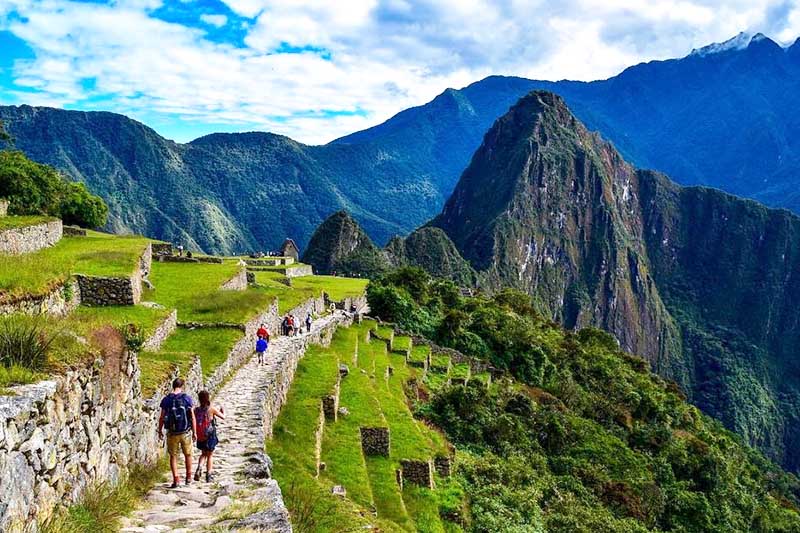
The Inca Trail was the network of roads that extended throughout the Inca empire
What is the Qhapac Ñan?
- Qhapac Ñan is a Quechua word that means ‘main road’. It was a system of roads established by the Inca empire, which covered more than 30 thousand kilometers through different geographies located in the current countries of Peru, Bolivia, Chile, Argentina, Ecuador and Bolivia.
- It is worth mentioning that this immense network of roads is famous for crossing the Andes Mountains, from the mountains of Argentina to the mountains of Colombia passing through the city of Cusco, the capital of the Inca empire. This route was built mainly using stone.
- Also admirable is the longitudinal route that ran along hundreds of kilometers of South American coastline bordering the Pacific Ocean. These roads were wider but did not have the consistency of stone but the softness of sand.
- The Inca roads of the highlands and the coast were joined by transversal stretches that, at the same time, forked into other stretches that penetrated jungle regions. In order to traverse these long stretches, the Incas built bridges, tunnels, causeways, walls, stairways, as well as deposits (colcas) and shelters (tambos).
The qhapac ñan road network was declared a World Heritage Site by UNESCO in 2014, after several years of work by the nations of Peru, Bolivia, Chile, Argentina, Ecuador and Colombia. A total of 780 kilometers and 291 archaeological sites were registered. Thanks to this declaration, Inca engineering is recognized worldwide. Likewise, it protects and preserves for the future the Inca sections and enclosures belonging to this network of roads.
What was its function?
The main function of the qhapac ñan was to communicate the city of Cusco, the center of Inca power, with the rest of the provinces of the empire. Likewise, because the roads were built during the expansionist period, they fulfilled a function of political, administrative, cultural and social domination of the recently conquered peoples.
Map of the Inca Trail
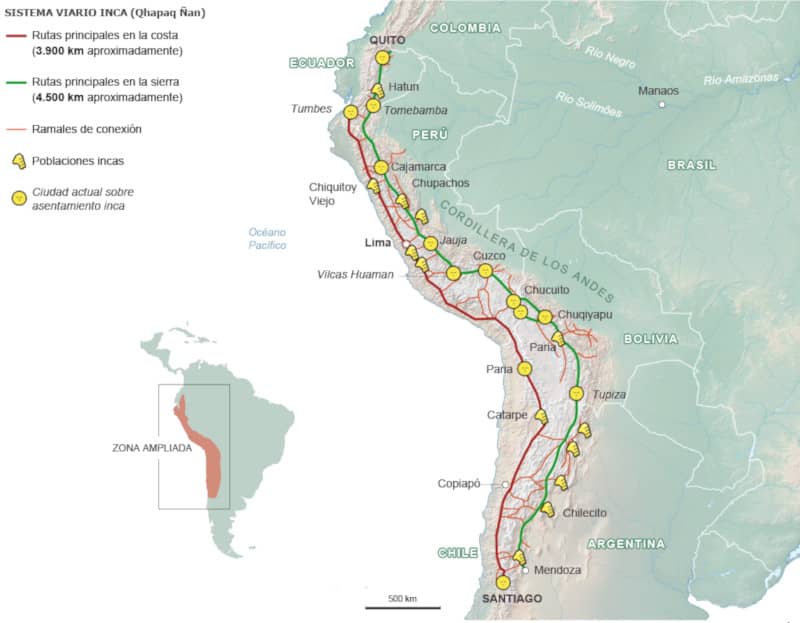
Map of the Inca Trail
History of the Inca roads
- During the pre-Inca period, the different cultures and human groups that inhabited the southwestern territory of South America built some stretches of roads that were improved and expanded during the Inca empire.
- The famous emperor Pachacutec (1400 – 1471) was the one who initiated the Inca expansionist process as well as the construction of the main stretches of qhapac ñan in the new conquered territory.
- The successor Inca emperors continued with the expansion of the Qhapac Ñan as well as the construction of bridges, warehouses and shelters along the roads.
- In the 16th century, the Spaniards arrived in Cusco, destroying the Inca empire and destroying its main temples, palaces and buildings. However, they kept many sections of the qhapac ñan, which favored them for trade.
- Currently, the Inca road network is considered ‘Cultural Heritage of Humanity’ by UNESCO. Many sections are protected by the nations where they are located. One of the most famous routes is the one that reaches Machu Picchu through the Intipunku, the original gateway to the Inca city.
The main roads
- Inca roads of the north coast – This route departed from the city of Cusco heading northwest towards the coast, crossing the present-day towns of Palpa, Nazca, Lima, Huarmey, Lambayeque, Piura, Tumbes, Quito and Pasto in Colombia.
- Inca roads of the northern highlands – This route departed from the city of Cusco, crossing the Andes Mountains in a northerly direction, passing through the current towns of: Vilcashuaman, Jauja, Tarma, Huanuco, Huaritambo, Huancabamba, Siguas, Conchuco, Andamarca, Huamachuco, Cajamarca, Chachapoyas, Tumibamba, Loja, Quito and Pasto in Colombia.
- Inca roads of the southern coast – This route departed from the city of Cusco in an easterly direction to connect to the royal road of the coast (crossing the current towns of Nazca, Palpa, Inca), and then followed the southern road through the towns of Tambo Colorado, Catarpe, Arica, Copiapó, the pampas of Tucumán to the Maule River in Chile.
- Inca roads of the southern highlands – This route departed from the city of Cusco crossing the Andes Mountains in a southerly direction including the Collao plateau. It went through the current towns of Juliaca, Chucuito, Chuquiago, La Paz, the pampas of Tucumán until descending to the city of Santiago in Chile.
The Inca bridges
The qhapac ñan crossed difficult geographies where only the use of a bridge could allow passage. Because of this, the Incas built different types of bridges, which can be divided as follows:
- Log bridges – Rustic and simple constructions that used the trunks of a tree to unify two nearby points. One of the most famous examples is the ‘Inca Bridge’ located at Machu Picchu.
- Hanging bridges – Constructions made of thatch joined together to form long rope bridges, which reached up to 60 meters in length. They had to be renewed from time to time. One of the most famous that survives to this day is the Inca bridge of Queswachaka.
- Stone bridges – Constructions made of rustic stone placed one on top of the other to form a solid path to cross short distances over precipices. Due to the passage of time, most of these types of structures were destroyed.
- Oroyas – Simple construction made of solid vegetable fibers that served as pillars, which carried people or food in a basket or board. They were mainly used to cross rainforest rivers. They are still used today in some communities.
- Floating bridges – Structures made of totora reeds (plant located on the islands of Lake Titicaca), which together served to transport people by water. They were used to navigate from one island to another in this Peruvian lake. Nowadays they are also used for the construction of simple boats./li>
The canal and drainage system
- The qhapac ñan made of stone that crossed the Andes Mountains had a system of drainage and canals that kept it solid in time and in spite of the frequent rains.
- For the construction of a section of the qhapac ñan, first a layout and foundations were laid. Then, the paving was done (preferably of stones). Finally, the drainage system was built together with the canalization. The roads were also maintained from time to time.
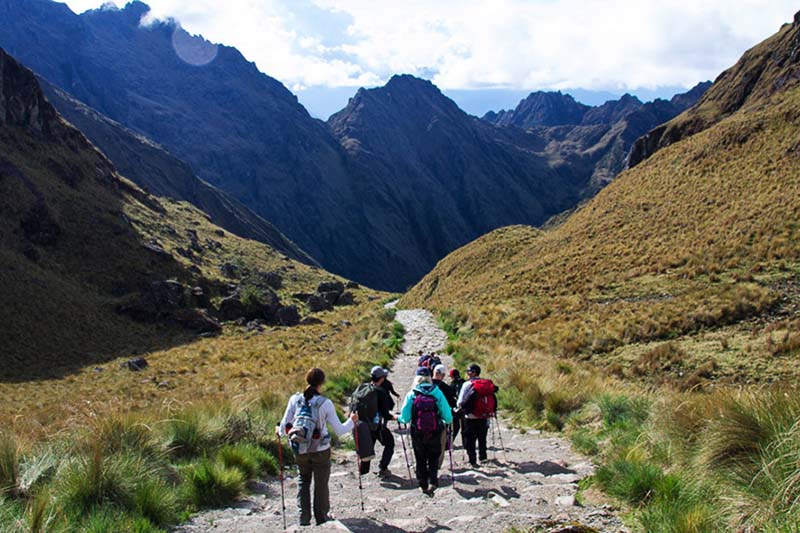
Inca roads built in the midst of the mountains
The Inca Trail to Machu Picchu
- The most famous stretch of the qhapac ñan in the world is the ‘Inca Trail to Machu Picchu‘. This route was used by the Incas to access the Inca city from Cusco. Currently, it is a route protected by the Peruvian State, which allows controlled tourist visits.
- The Classic Inca Trail to Machu Picchu lasts 4 days and 3 nights. It covers 39 kilometers on foot, from kilometer 39 of the train track in Ollantaytambo to the Intipunku (sun gate), the entrance to the original Inca city.
- To do this route you must book a tour with an authorized tourism agency. The tours include everything: entrance fees, food, camping, guides, transportation and more.
- Because this is one of the best trekking routes on the planet, the tour must be booked online 5 to 6 months in advance.

The Inca trail in the middle of the jungle brow
Additional Information
- The apachetas were offerings that the Incas made during their journeys along the Inca roads. They consisted of placing one stone on top of another to invoke good luck for the long journey. This custom is still in force in the Andean peoples, who still worship the mountains (Inca gods).
- For the construction of the qhapac ñan, the Incas adapted to the geography. On the coast the roads were wider. In the highlands they meandered through mountains and in the jungle they crossed narrow cliffs. However, they always took care of nature, finding harmony between the roads and the natural life around them.
Frequently asked questions about the Qhapac Nan
-
1) Where are the Qhapac Nan?
The Qhapac Nan are located along more than 30,000 kilometers in the current territories of Peru, Bolivia, Chile, Argentina, Colombia and Ecuador.
-
2) Where can I visit the qhapac ñan?
The qhapac ñan can be visited along the protected areas of Peru, Bolivia, Chile, Argentina, Colombia and Ecuador. The most famous stretch is the one that connects with the Inca city of Machu Picchu.
-
3) Who built the qhapac ñan?
The qhapac ñan were built by the Incas during the 15th century. The emperor Pachacutec was the one who began to organize the construction of these roads.
-
4) What was the function of the qhapac ñan?
The qhapac ñan had the function of uniting the city of Cusco (capital of the Inca empire) with the rest of the newly conquered provinces and regions of the empire.
-
5) How much does it cost to visit the qhapac ñan?
The qhapac ñan do not have a specific cost. Some sections are adequately preserved to be visited by tourists. The most famous stretch is the 39 kilometers of qhapac ñan that connect with Machu Picchu.
-
6) Do qhapac ñan exist on the coast?
Yes, the Incas built qhapac ñan on the Pacific coast. These roads were flat and delimited on both sides. Due to the sandy terrain many stretches have disappeared over time. The qhapac ñan in the mountains (Cordillera de los Andes) are the best preserved.
-
7) Do qhapac ñan exist in the jungle?
No, the Incas did not build stretches of qhapac ñan in the thick South American jungle. On the other hand, they did build sections in the high mountainous jungle.
-
8) Can the qhapac ñan disappear?
Without due care, qhapac ñan can give way to highways and modern buildings. However, the authorities of each country implement measures for their conservation. Currently, the qhapac ñan are considered Cultural Heritage of Humanity by UNESCO.
-
9) What is the most famous section of the qhapac ñan?
Definitely the most famous stretch of the qhapac ñan is the 39 kilometer stretch that runs through the mountains and jungle region of Cusco until it ends at Machu Picchu.
-
10) What are the qhapac ñan made of?
The qhapac ñan is made of different materials, but among all of them, stone stands out. The Andean sections are cemented by several layers of stone. This keeps them in a good state of preservation until today.
Advice from people who have been there
 By: Viviana M.
By: Viviana M.“Incredible“
“It is one of the most strenuous and wonderful routes to Machupicchu; it has everything I expected from a great hike, landscapes, flora, fauna, as well as shady Inca constructions.“
By Ticket Machu Picchu – Last updated, August 16, 2024
The post The Inca Trail – Qhapac Ñan first appeared on Ticket Machu Picchu.
]]>The post New Discoveries on the Inca Trail to Machu Picchu first appeared on Ticket Machu Picchu.
]]>Machu Picchu never ceases to amaze locals and strangers, it continues to give researchers something to talk about, and many new reasons to people who have Machu Picchu on their bucket list. New findings were found on the Inca Trail to Machu Picchu; these reaffirm the devotion that the Incas felt for water and the fertility of animals in the Andean culture.
- New archaeological evidence on the Inca Trail to Machu Picchu
- Frequently asked questions about Huayna Picchu mountain
- Important
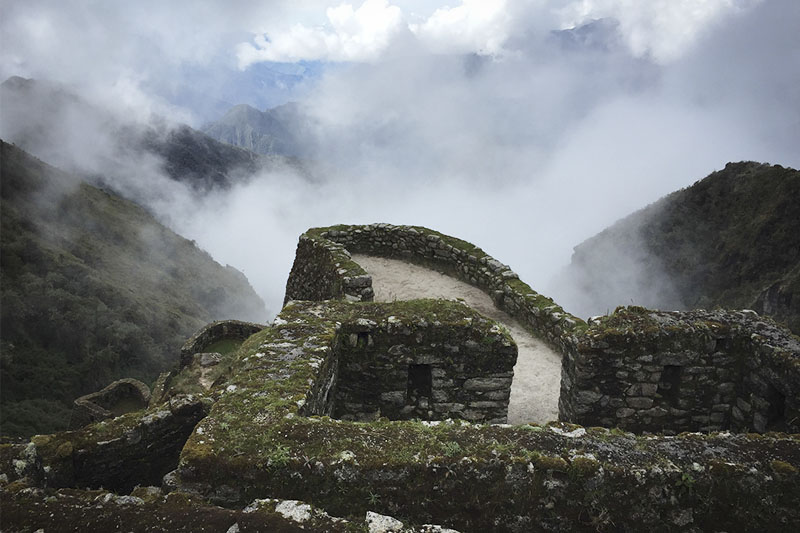
New findings on the Inca Trail to Machu Picchu
New archaeological evidence on the Inca Trail to Machu Picchu
Ceremonial spaces, burial sites, cave paintings and rock shelters were found on the Inca Trail to Machu Picchu in Cusco, Peru; the archaeological evidence was found at kilometer 88 of the route from Ollantaytambo to Machu Picchu, on the left side of the Urubamba (Vilcanota) River, on the Taparayoq Tunasmoqo hill.
These archaeological remains must have been a sacred place, due to their orientation to the mountains such as La Veronica (Wakaywillka), Misti (Casamintuyoc) and the Urubamba River (Wilkamayu) in the Sacred Valley of the Incas.
Frequently asked questions about Huayna Picchu mountain
Rock Paintings
The cave paintings found are anthropomorphic geometric figures, snakes, camelids, birds, foxes, toads, zigzagging lines that would represent the “God Illapa” (lightning), figures of plants, some similar to corn, straight lines, and circles; most of them are red in different shades. It is possible that all the representations found in Taparayoq – Tunasmoqo, represent the Andean ideology of the Water Cult, the fertility of the herds of llamas and alpacas, which are shown as robust, pregnant, and at different ages. These paintings were found in the middle and high part of the hill inside rock shelters.
Constructions
In the lower part of the slopes of the Taparayoq Tunasmoqo hill, circular and rectangular enclosures, retaining walls, terraces, water channels and funerary contexts were found that could have been built during the intermediate period (Killke culture period) and the late horizon (Inca period). They house cave paintings associated with funerary contexts, burial structures and ceremonial wakas. These sites suffered indiscriminate looting (plundering) at some point in their history, but some skeletons were found, which are being studied.
Other possible findings
It is probable that the Taparayoq – Tunasmoqo hill holds other places with cave paintings; however, exploration would demand several days of hiking up and down trails to and from the Inca Trail. The whole territory is a difficult access area full of hills, rocky walls and cliffs.
Conservation work
The specialists point out several factors that have damaged the paintings; the humidity of the area, the rains, the wind and their exposure to the sun. But restoration and conservation works are being carried out in order to be able to show these new findings to the whole world as soon as possible.
Important
If you want to hike the Inca Trail to Machu Picchu in Cusco, you should book the entrance tickets 6 months in advance; if you do not find available tickets, you may want to check the availability of Machu Picchu tickets; they also have to be booked in advance, especially the Machu Picchu + Huayna Picchu ticket.
We can help you organize your entire trip to Machu Picchu, whether you wish to enter by the Inca Trail or by train through the Sacred Valley of the Incas; just contact us at [email protected].
Advice from people who have been there
 By: Diana R.
By: Diana R.“It is marvelous“
“If you are reading this, it is because you are interested in doing the Inca Trail, do not hesitate, do it, it is wonderful. Thank God we found this agency (there is no way to do it without hiring one); our tour was great, personalized attention since we asked them the first question until the day we returned to our country.“
By Ticket Machu Picchu – Last updated, August 16, 2024
The post New Discoveries on the Inca Trail to Machu Picchu first appeared on Ticket Machu Picchu.
]]>